19 Recipes From Jewish Latin American Families
18 Recipes
19 Recipes From Jewish Latin American Families
18 Recipes
The Jewish communities of Latin America are wonderfully diverse — as are their dishes, often capturing a blend of Sephardi, Ashkenazi, North African, or Middle Eastern flavors and those from the countries they settled in, in the New World.
The first Jews to arrive in what’s now referred to as Latin America arrived after the Spanish expulsion — some as crypto-Jews. Other waves came later, like Esther Weyl’s community, which migrated from Morocco to Brazil to work in the rubber industry in the 19th century. And there are Jewish families like Joel Linkewer’s, who arrived in the 1930s, fleeing rising antisemitism in Europe. These are not the only waves of Jewish immigration to the region, there are Jews who arrived in the 1920s when the U.S. placed limits on immigration from Eastern Europe, those who came after WWII, families that fled Middle Eastern countries after the establishment of Israel, and others.
On their tables, you may find recipes unchanged by the journey like the potato blintzes of Joel’s family, which serves them alongside ceviche and tostones at Hanukkah. There are also recipes like ones from Esther’s community, which adapted their Moroccan Shabbat stew dafina in Brazil by replacing chickpeas with flour dumplings. Like all Jewish cooks, the ones featured in this collection made the most of the ingredients they had on hand — including fresh fish and fruits like guava and plantains.
Please note: This collection doesn’t include recipes from Jewish families in Mexico. Those recipes will be featured in an upcoming collection this winter. For more Jewish recipes, check out our full archive.
Recipes in This Collection
1. Guava Challah
Shabbat
2. Spicy Corvina Ceviche
Hanukkah
3. Fumaça (Roasted Eggplant Dip)
Shabbat
4. Roasted Pepper Salad
Shabbat
5. Kemia de Remolachas (Beet Salad With Cumin)
Passover
6. Fried Potato Blintzes
Hanukkah
7. Fish Albondigas (Fish Balls in Tomato Sauce)
Shabbat
8. Pescado Picante (Spicy Fish With Cilantro and Fava)
Quick
9. Cojada (Potato Casserole)
Shabbat
10. Almoronia (Baked Chicken and Eggplant)
Shabbat
11. Dafina (Overnight Shabbat Stew)
Shabbat
12. Ropa Vieja (Beef Braised With Tomatoes and Spices)
13. Pastel de Choclo (South American Corn and Beef Casserole)
Shabbat
14. Ají de Gallina (Peruvian Chicken Curry)
Shabbat
15. Tacu-Tacu (Peruvian Lima Bean Cakes)
Shabbat
16. Meringue With Orange Marmalade
Shabbat
17. Torta de Datiles (Date and Walnut Cake)
Easy
18. Pastelitos (Sweet Hand Pies Filled With Guava and Cheese)
Shared by Monica Haim
1. Guava Challah
Yield: 2 loavesTime: 45 min active + 3 h 45 min inactiveShared by Monica Haim
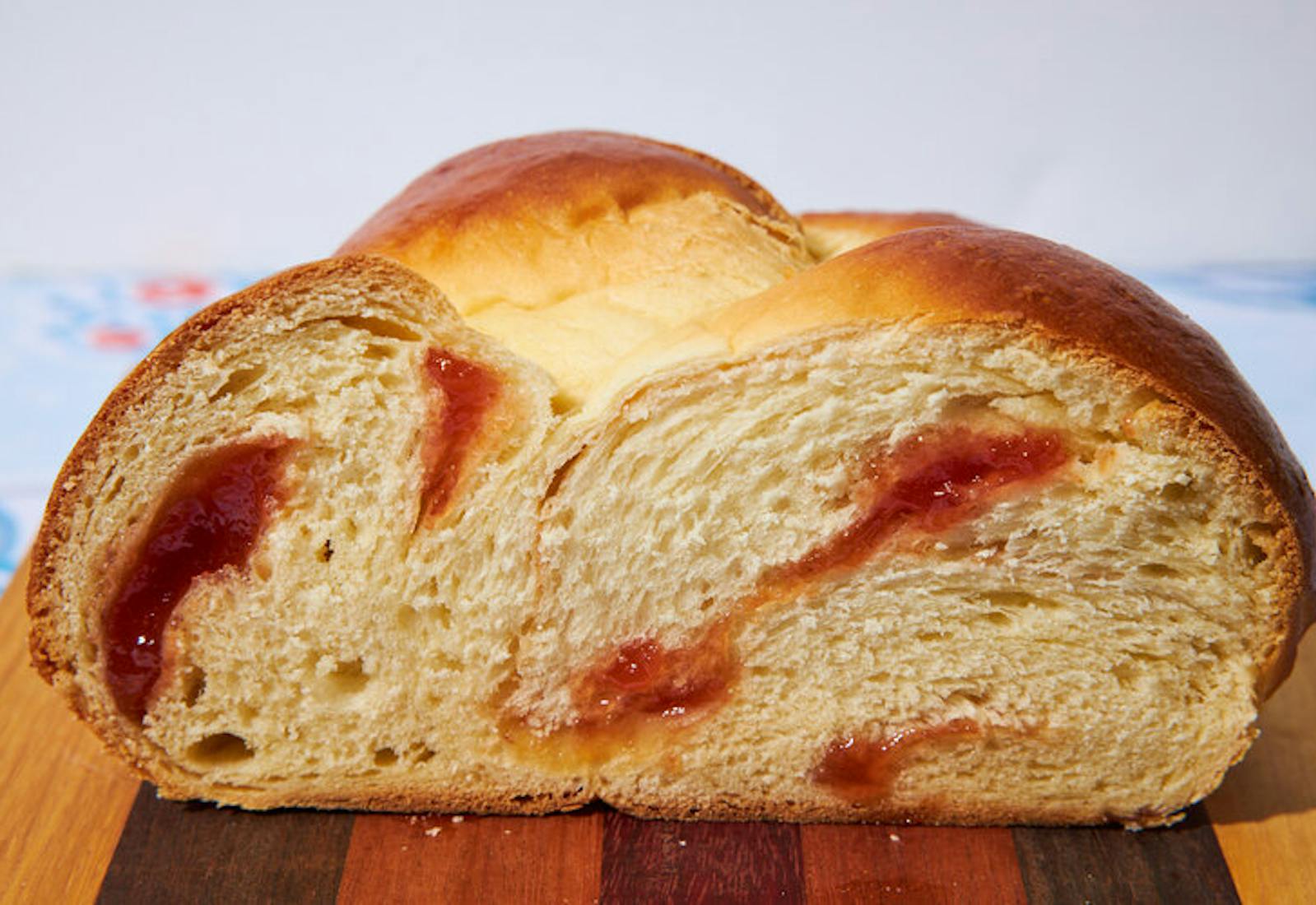
1. Guava Challah
Yield: 2 loavesTime: 45 min active + 3 h 45 min inactiveThis recipe was shared by Monica Haim. Read more about her family in "In Rural Alaska, Monica Haim Dreams of a Colombian-Miami Feast" and try her recipes for torta de datiles (date and walnut cake), arroz con fideos (rice with vermicelli noodles), and torta de espinaca (spinach and cheese pie).
Ingredients
- 2 cups warm water, divided
- ¾ cup + 1 tablespoon sugar, divided
- 2 tablespoons rapid rise yeast
- 5 eggs, divided
- 1 tablespoon kosher salt
- ½ tablespoon vanilla extract
- 8 ¾ cups all-purpose flour
- ½ cup olive oil, plus more for greasing
- 6 tablespoons guava jelly
Preparation
Step 1
In the bowl of a stand mixer fitted with a dough hook, combine the yeast, 1 tablespoon sugar, and 1 cup of warm water. Let stand for 5 minutes until it becomes foamy. Add the remaining ¾ cup sugar, 3 eggs, salt, and vanilla, and mix well. Add the remaining 1 cup of warm water.
Step 2
With the mixer on low, add half of the flour, mixing until just combined. Add half of the oil, then mix to combine. Repeat with the remaining flour and oil. Turn the mixer to medium, and mix until the dough becomes smooth and pulls away from the sides, about 8 minutes.
Step 3
Transfer the dough to a large oiled bowl, and cover with a damp towel or plastic wrap. Let rise in a warm place for 1 hour. After it’s risen, knead down the dough in the bowl for a few turns, and re-cover for 1 hour. Repeat once more, for a total rise time of 3 hours.
Step 4
Line 2 baking sheets with parchment paper. Mix 2 eggs with 1 tablespoon of water to make an egg wash.
Step 5
Once the dough has risen, transfer to a lightly oiled surface.
Step 6
Roll the dough out to a large rectangle, about 10 inches wide and 18 inches long. Cut evenly into 6 strips. Roll each strip to be 3 inches wide. Working one strip at a time, spread 1 tablespoon of guava jelly in a line along the side of one length, and lightly brush the other side of the length with the egg wash. Roll the strip so that it seals in the jelly, then pinch closed along the egg wash edge to seal completely. Using your hands, roll into longer strips, about 18-20 inches long. Lightly dust the strips with flour to avoid sticking.
Step 7
Once you have filled and sealed all 6 strips, form into two braided loaves, making sure to keep the seam sides of each strip towards the inside of the braid to prevent leaking. Place each loaf on a parchment-lined baking sheet, loosely cover with plastic or a towel and let rise for 40-45 minutes more, until the dough springs back when lightly poked.
Step 8
Preheat the oven to 350 degrees. Lightly brush the loaves with egg wash, and bake for 40 minutes. Halfway through baking, switch the loaves’ position in the oven: the lower loaf moves to the upper rack, and vice versa. This will help them bake evenly and not burn. Bake until golden. Let cool and serve.
Shared by Joel Linkewer
2. Spicy Corvina Ceviche
Yield: 6-8 servingsTime: 35 minShared by Joel Linkewer
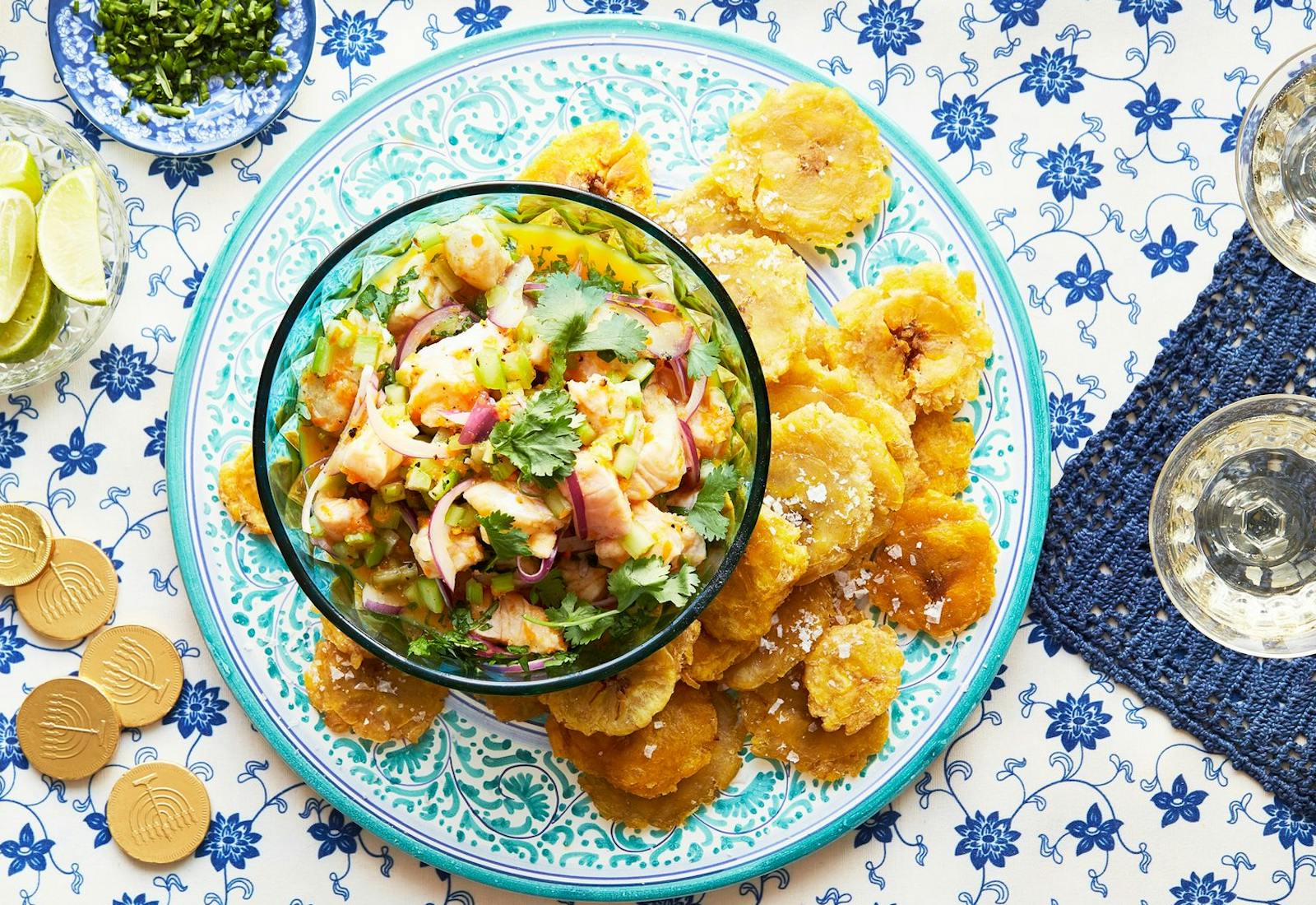
2. Spicy Corvina Ceviche
Yield: 6-8 servingsTime: 35 minThis is a spicy dish, so you can reduce the amount of scotch bonnets based on your spice preference.
This recipe was shared by Joel Linkewer. Read more about his family in "Blintzes, Tostones, and Ceviche, This Family’s Hanukkah Spread Is a Map of Their History" and try his recipes for fried potato blintzes and tostones (fried plantains).
Plus, find more Hanukkah recipes in our holiday collection.
Ingredients
- 3 Scotch Bonnet Peppers, stems removed (orange color is best)
- 12 limes, juiced, divided (1 ½ cups)
- 3 tablespoons kosher salt
- 2 teaspoons ground black pepper
- 2 pounds Corvina or sea bass non-skin filets, cut into 1-inch cubes
- 4 celery stalks, finely diced
- 1 small red onion, thinly sliced
- 1 cup loosely packed cilantro, roughly chopped
Preparation
Step 1
In a small food processor, pulse the Scotch Bonnet Peppers and the juice of 2 limes (¼ cup) for 30 seconds, until the peppers are well chopped.
Step 2
In a medium bowl, add the remaining lime juice, the Scotch Bonnet Pepper mixture, salt, and pepper. Mix, cover it plastic wrap and chill for 1 hour in the refrigerator.
Step 3
Remove from the refrigerator and add the fish. Mix well, and chill the mixture for an additional hour, mixing again halfway through.
Step 4
Remove from the refrigerator and add the celery, onion, and cilantro. Mix well and serve immediately.
Shared by Esther Serruya Weyl
3. Fumaça (Roasted Eggplant Dip)
Yield: 6 to 8 servingsTime: 30 minShared by Esther Serruya Weyl
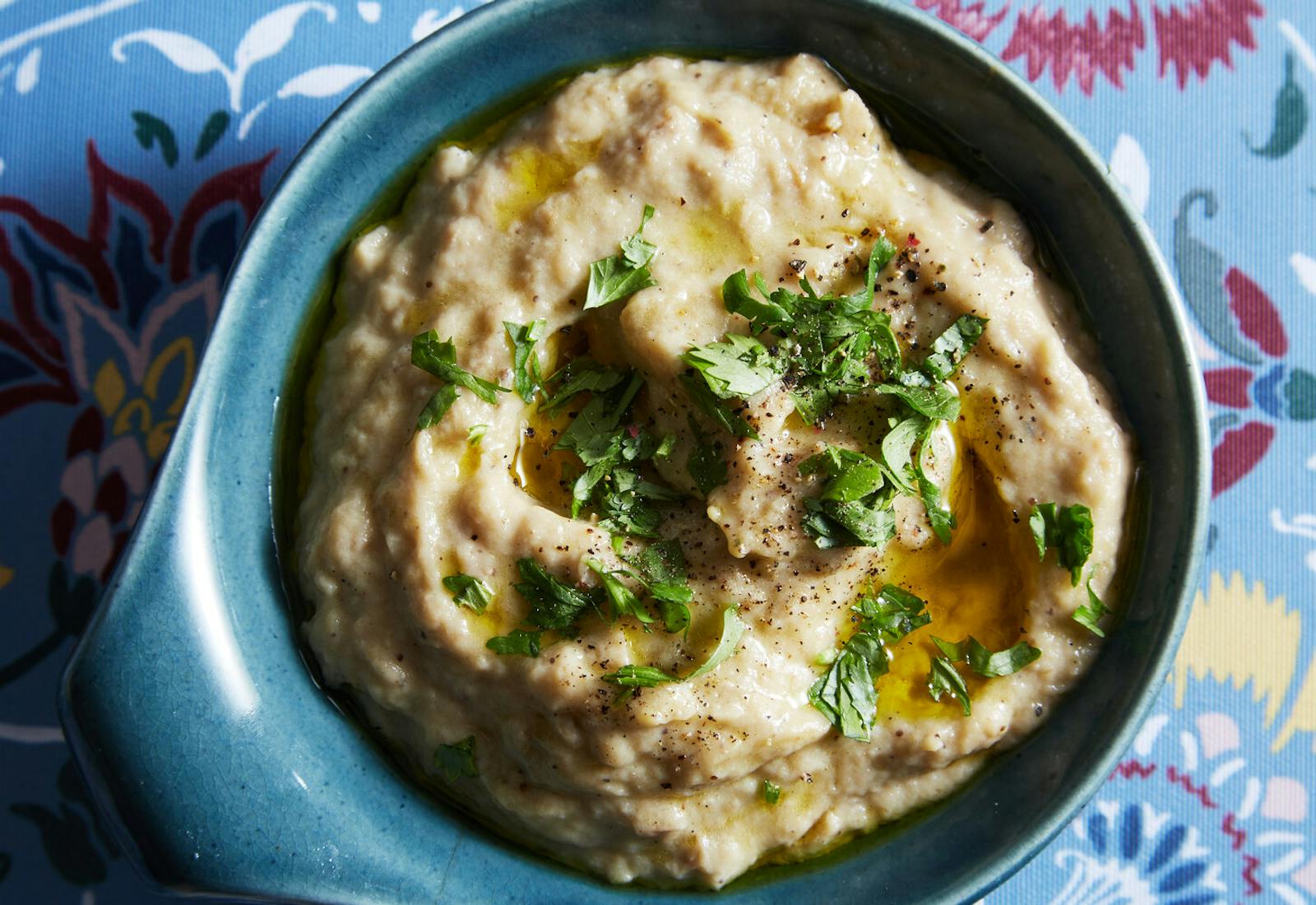
3. Fumaça (Roasted Eggplant Dip)
Yield: 6 to 8 servingsTime: 30 minThis recipe is featured in our cookbook "The Jewish Holiday Table: A World of Recipes, Traditions & Stories to Celebrate All Year Long." For more holiday recipes from around the world, get your copy!
This recipe was shared by Esther Serruya Weyl. Read more about her family in " 130 Years in, a Brazilian Community’s Shabbat Recipes Live On" and try her recipes for roasted pepper salad, cojada, and almoronía.
Ingredients
- 1 large eggplant (about 1¼ pounds)
- 1 large egg yolk
- 1 tablespoon white wine vinegar or white vinegar, or more to taste
- 1 teaspoon kosher salt
- ¼ teaspoon freshly ground black pepper
- ¾ cup mild extra-virgin olive oil or vegetable oil
- 4 cilantro sprigs for garnish
- Extra-virgin olive oil for drizzling
Preparation
Step 1
Roast the eggplant using the method that works best for your kitchen: You can place the eggplant directly on a gas burner turned to medium-high heat and cook, flipping it frequently, until it is charred on all sides and tender inside, about 20 minutes. (Lay a few strips of foil around the burner for easy cleanup.) Or char the eggplant skin under a hot broiler, turning the eggplant frequently, and then finish roasting it until tender on a baking sheet in a 450°F oven. Remove the eggplant from the heat and let it rest until cool enough to handle.
Step 2
Halve the eggplant lengthwise and scoop the eggplant flesh into a blender. Discard the skin and stem.
Step 3
Add the egg yolk to the blender and pulse until well combined. Add the vinegar, salt, and pepper and blend for another few seconds. With the motor running, slowly stream in the mild olive oil and blend until the mixture is thick and creamy. Taste and adjust the seasoning with more vinegar, salt, and pepper if needed.
Step 4
Transfer the dip to a small serving bowl, garnish with the cilantro sprigs, and drizzle lightly with olive oil. Serve at room temperature.
Shared by Esther Serruya Weyl
4. Roasted Pepper Salad
Yield: 6 servingsTime: 30 minShared by Esther Serruya Weyl
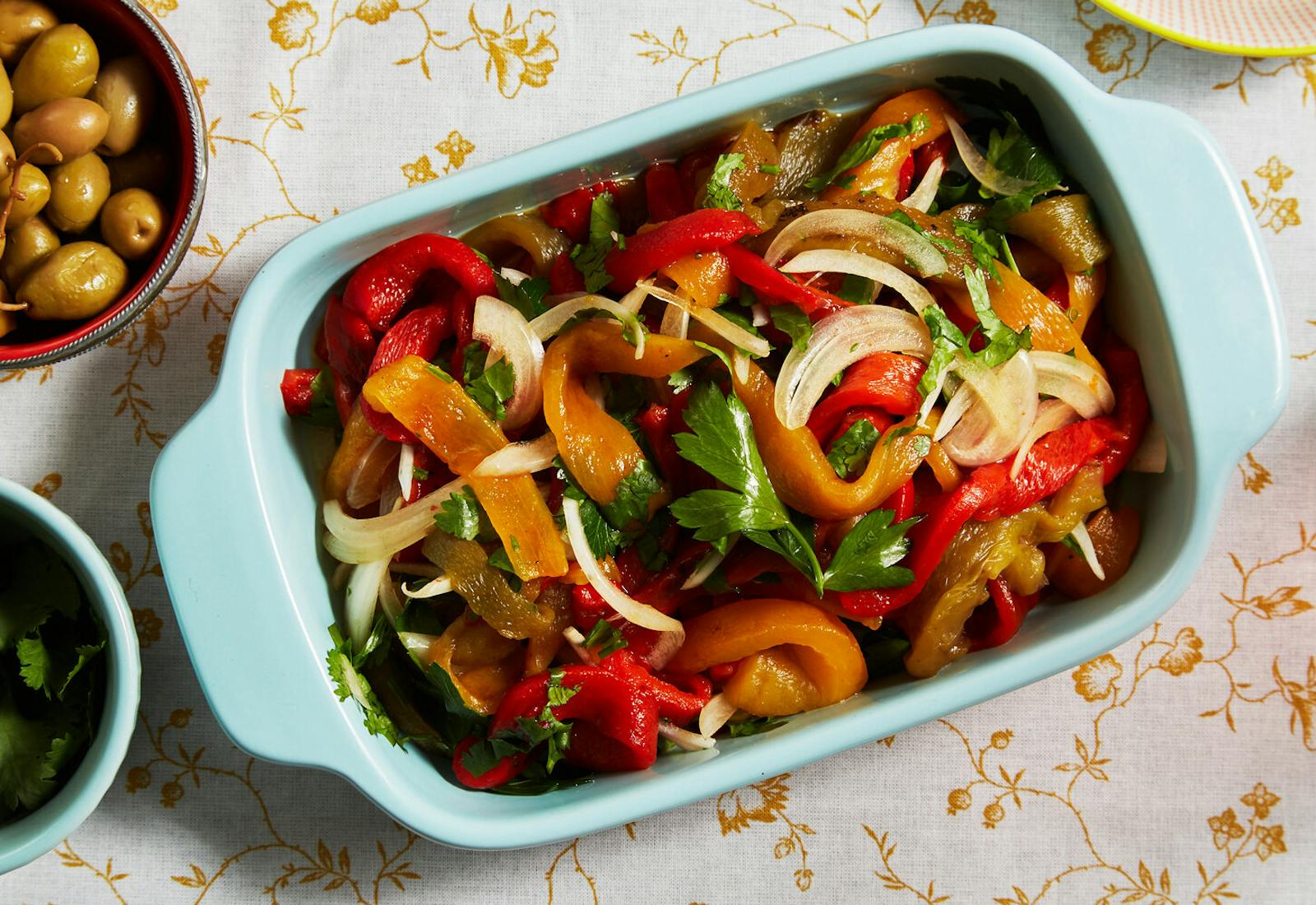
4. Roasted Pepper Salad
Yield: 6 servingsTime: 30 minThis recipe was shared by Esther Serruya Weyl. Read more about her family in " 130 Years in, a Brazilian Community’s Shabbat Recipes Live On" and try her recipes for fumaça, cojada, and almoronía.
Ingredients
- 3 red peppers
- 2 yellow peppers
- 1 green pepper
- ½ onion, thinly sliced
- ½ cup olive oil + 1 tablespoon
- 1 spoon white vinegar
- ¼ teaspoon salt
- ⅛ teaspoon ground black pepper
- ½ teaspoon cumin
- ¼ bunch cilantro leaves, roughly chopped
Preparation
Step 1
Place peppers directly on the flames of a gas stovetop over medium high heat. Cook the peppers, flipping them occasionally until charred on all sides and tender inside, about 10 minutes. Set the peppers aside until cool enough to handle. Peel the charred skins from the peppers and scoop out the seeds. Slice the cleaned peppers lengthwise into ¼ inch thick slices. Set aside.
Step 2
Place a saucepan over medium heat. Add 1 tablespoon of olive oil and the sliced onions. Saute until translucent, about 5 to 7 minutes. Set aside to cool.
Step 3
In a mixing bowl, place the pepper slices, sauteed onions, ½ cup olive oil, vinegar, salt, pepper, cumin, cilantro. Combine well.
Step 4
Serve at room temperature.
Shared by Jessica Solnicki
5. Kemia de Remolachas (Beet Salad With Cumin)
Yield: 6 servingsTime: 45 minShared by Jessica Solnicki

5. Kemia de Remolachas (Beet Salad With Cumin)
Yield: 6 servingsTime: 45 minThis recipe is featured in our cookbook "The Jewish Holiday Table: A World of Recipes, Traditions & Stories to Celebrate All Year Long." For more holiday recipes from around the world, get your copy!
This recipe was shared by Jessica Solnicki. Read more about her family in "Remembering a Tunisian Matriarch at an Argentine Seder Table" and try her recipes for charoset with dates, pistachio and rose water, msoki de pesaj, and cneidalaj.
Ingredients
- 3 beets
- 1 tablespoon + 2 teaspoons kosher salt, divided
- 1 tablespoons olive oil
- 2 teaspoons ground cumin
- 2 teaspoons kosher salt
- ¼ teaspoon ground black pepper
Preparation
Step 1
Place the beets in a pot and submerge completely with cold water and a tablespoon of salt. Bring to a boil and cook for about 30 minutes until fork tender.
Step 2
Drain the beets. Let cool for 10 minutes and peel and cut the beets into ¼ inch cubes.
Step 3
Add the olive oil to a skillet over medium heat. Add the beets, cumin, remaining 2 teaspoons of salt and pepper and sauté until coated, about 3 minutes.
Step 4
Transfer to a bowl and serve warm or at room tempurature.
Shared by Joel Linkewer
6. Fried Potato Blintzes
Yield: 16 blintzesTime: 2 hShared by Joel Linkewer
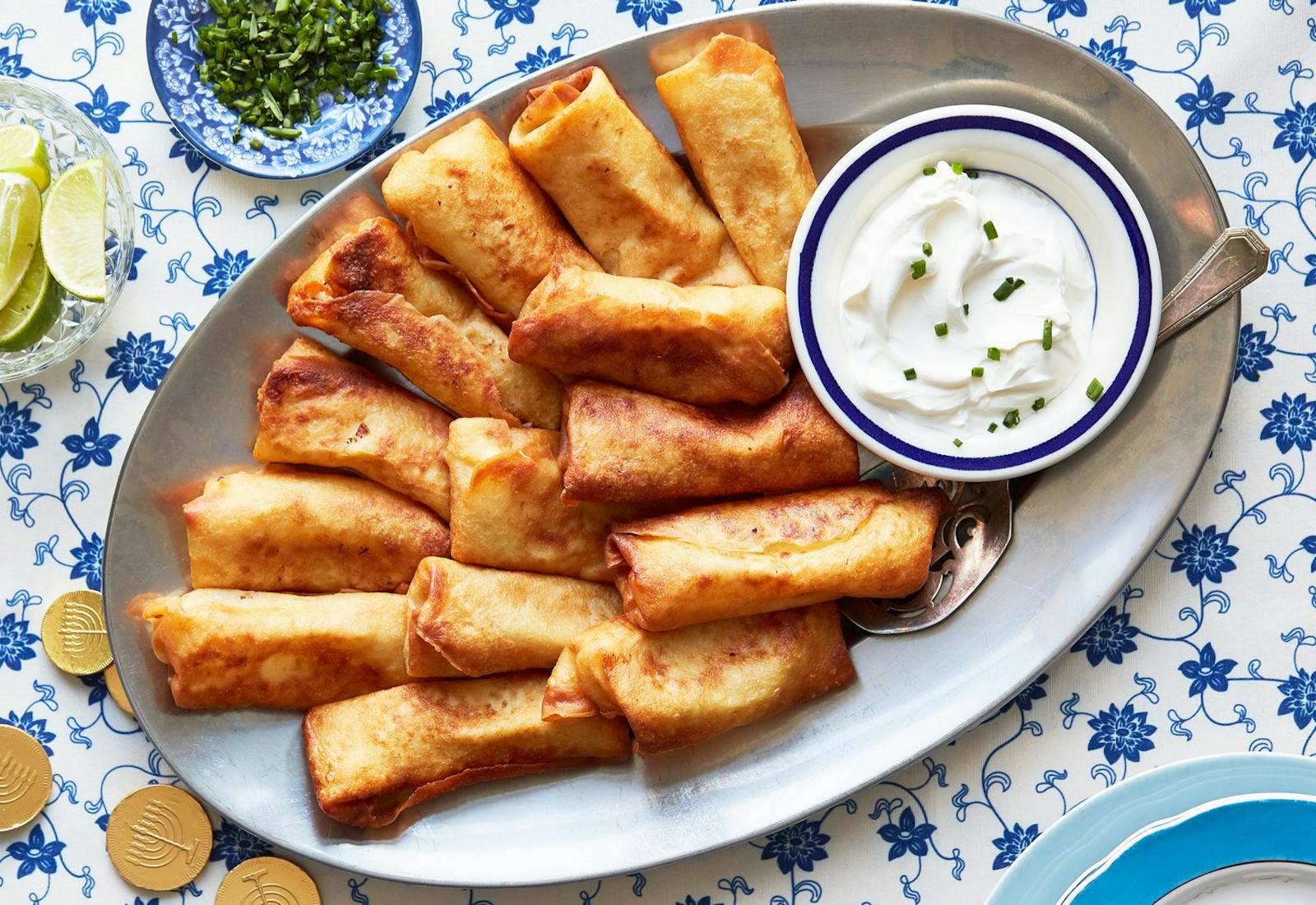
6. Fried Potato Blintzes
Yield: 16 blintzesTime: 2 hYou can make the crepes and filling 1 day ahead of time. Cover and refrigerate overnight, then fill and assemble the next day. This recipe can easily be doubled to serve a crowd.
This recipe was shared by Joel Linkewer. Read more about his family in "Blintzes, Tostones, and Ceviche, This Family’s Hanukkah Spread Is a Map of Their History" and try his recipes for spicy corvina ceviche and tostones (fried plantains). Plus, find more Hanukkah recipes in our holiday collection.
Ingredients
For the filling
- 2 tablespoons butter
- 2 large yellow onions, finely diced
- 4 russet potatoes, peeled and cut into ½-inch cubes
- 3 cloves of garlic, peeled and crushed
- 2 teaspoons kosher salt
- ½ teaspoon black pepper
For the crepes and assembly
- 2 cups all purpose flour
- 2 cups whole milk
- ½ cup seltzer water
- 4 eggs
- 2 tablespoons butter, melted, divided, plus more as needed
- Non-stick cooking spray
- Vegetable oil, for frying
- Sour cream and thinly sliced chives, for serving
Preparation
Step 1
Prepare the filling: Add the potatoes and garlic to a large pot, cover with cold water, and add 2 teaspoons of salt. Cover and bring to a boil. Cook for 10 minutes, until the potatoes are easily cut with a fork. Drain and put through a potato ricer or pass through a fine sieve. Transfer to a large bowl.
Step 2
While the potatoes cook, melt the butter over medium heat in an 8-inch nonstick skillet. Add the onions and 2 teaspoons of salt, and cook for 10 minutes until golden. Combine with the potatoes, add pepper, and adjust seasoning as needed. Set aside. Wipe out the skillet and set aside.
Step 3
Make the crepes: In a large bowl, whisk the flour, milk, seltzer, eggs, and 2 tablespoons of melted butter until no lumps remain.
Step 4
Spray the skillet with non-stick cooking spray or melt 1 tablespoon butter in the same 8-inch nonstick skillet over medium-low heat. Pour a ¼ cup of batter into the skillet and tilt to spread the batter in a very thin layer. Make sure to spread the batter evenly around the pan. Cook 2 minutes per side, until set. Transfer to a plate lined with parchment, and repeat with remaining batter. Set the skillet aside.
Step 5
Assemble the blintzes: add ¼ cup of the filling in a line near the bottom edge of the crepe. Fold the lower edge up and over the filling. Then, fold each side in about 1-inch, and roll up, ending with the seam side facing down. Repeat with remaining filling and crepes.
Step 6
Add ¼ cup of oil to the skillet and heat over medium. Working in batches, gently fry the blintzes for 1-2 minutes on each side, until they are lightly browned. Transfer to a cooling rack or paper towel-lined plate to drain excess oil. Serve warm, with sour cream and chives.
Shared by Esther Serruya Weyl
7. Fish Albondigas (Fish Balls in Tomato Sauce)
Yield: 4 to 6 servingsTime: 1 hShared by Esther Serruya Weyl
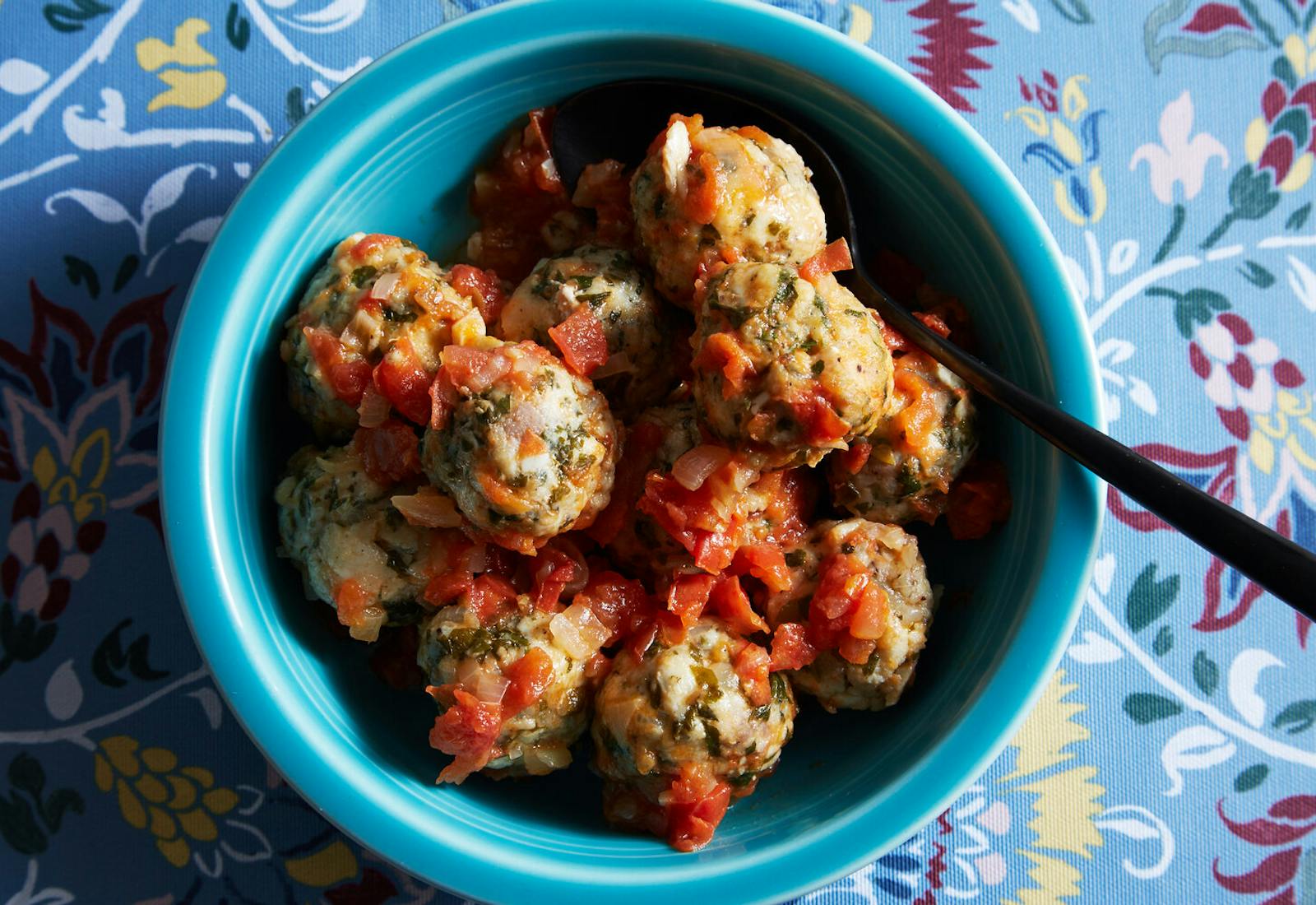
7. Fish Albondigas (Fish Balls in Tomato Sauce)
Yield: 4 to 6 servingsTime: 1 hThis recipe was shared by Esther Serruya Weyl. Read more about her family in " The Recipes That Connect This Brazilian Community to Its Moroccan Roots" and try her recipes for escabeche de piexe and meringue with orange marmalade.
Ingredients
For the sautéed onion and garlic mixture
- 1 onion, finely chopped
- 3 garlic cloves, finely chopped
- 1 tablespoon olive oil
For the fish balls
- 1 pound skinless red snapper filet, finely chopped
- 1 tablespoon breadcrumbs
- 1 teaspoon vegetable oil
- ¼ bunch cilantro leaves, finely chopped
- ¼ bunch parsley leaves, finely chopped
- ¼ teaspoon nutmeg
- Juice of ½ lime
- 1 teaspoon kosher salt
- ⅛ teaspoon ground black pepper
- ½ of sauteed onion and garlic mixture
For the sauce
- 8 to 10 plum tomatoes, deseeded and finely chopped
- ½ of sauteed onion and garlic mixture
- 1 teaspoon salt
- 1 cup water
- 1 tablespoon olive oil
Preparation
Step 1
Place a saucepan over medium heat. Add 1 tablespoon of olive oil and add the onions and garlic. Saute until translucent and starting to brown, about 10 minutes. Remove from heat and set aside to cool.
Step 2
Place the chopped fish, breadcrumbs, cilantro, parsley, nutmeg, lime juice, salt, pepper, and half of the sautéed onion and garlic mixture into a large mixing bowl. Mix until combined well. Set aside.
Step 3
Place a deep saucepan over medium to high heat. Add the remaining sauteed onion and garlic, tomatoes, 1 teaspoon of salt, and cook for about 15 to 20 minutes until the tomatoes thicken and cook through. Add 1 cup of water. Stir mixture well and bring it to a simmer. Cook for about 20 more minutes until the sauce thickens.
Step 4
Take 1 tablespoon of the fish mixture, form it into a ball shape with your palms and place it into the simmering sauce. Continue with the rest of the fish mixture until all the fish balls are submerged in the tomato sauce. Cook the fish balls uncovered for about 10 to 15 minutes until they are cooked through.
Step 5
Serve the albondigas hot with a side of rice.
Shared by Monica Haim
8. Pescado Picante (Spicy Fish With Cilantro and Fava)
Yield: 2-3 servingsTime: 30 minShared by Monica Haim

8. Pescado Picante (Spicy Fish With Cilantro and Fava)
Yield: 2-3 servingsTime: 30 minThis recipe was shared by Monica Haim. Read more about her family in "In Rural Alaska, Monica Haim Dreams of a Colombian-Miami Feast" and try her recipes for torta de datiles (date and walnut cake), arroz con fideos (rice with vermicelli noodles), and torta de espinaca (spinach and cheese pie).
Ingredients
- 3 halibut fillets, cut into 2-inch pieces, (18-20 ounces total)
- 4 cloves garlic, grated or pushed through a garlic press
- 2 tablespoons extra virgin olive oil
- 1 ½ teaspoons kosher salt
- 1 large bunch cilantro
- 1 red hot chili pepper (or other spicy pepper), halved and seeded
- 1 cup fresh fava beans, removed from pods, or frozen and defrosted
- ⅛ teaspoon turmeric
- ⅛ teaspoon cayenne pepper
- ⅛ teaspoon white pepper
- ⅛ teaspoon black pepper
Preparation
Step 1
In a large bowl, add the halibut, garlic, olive oil and salt. Mix well to combine, and set aside to marinate.
Step 2
Separate the cilantro leaves from stems. Lay the stems on the bottom of a large pot as a base. Arrange the marinated halibut pieces on top of the cilantro stems in a single layer.
Step 3
Add 1 ½ cups of water to the pot. It should come halfway up the sides of the fish. Add more if needed.
Step 4
Add the chili pepper to the pot (either a half or whole, depending on your spice preference), along with the fava beans, turmeric, cayenne and ground peppers.
Step 5
Cover everything with the cilantro leaves, and place the lid on the pot. Simmer on low heat for 10-12 minutes, or just until the halibut starts to perfectly flake.
Step 6
Spoon sauce over the chunks and serve with white rice, couscous or any other favorite grain.
Shared by Esther Serruya Weyl
9. Cojada (Potato Casserole)
Yield: 4 to 6 servingsTime: 1 h 30 minShared by Esther Serruya Weyl
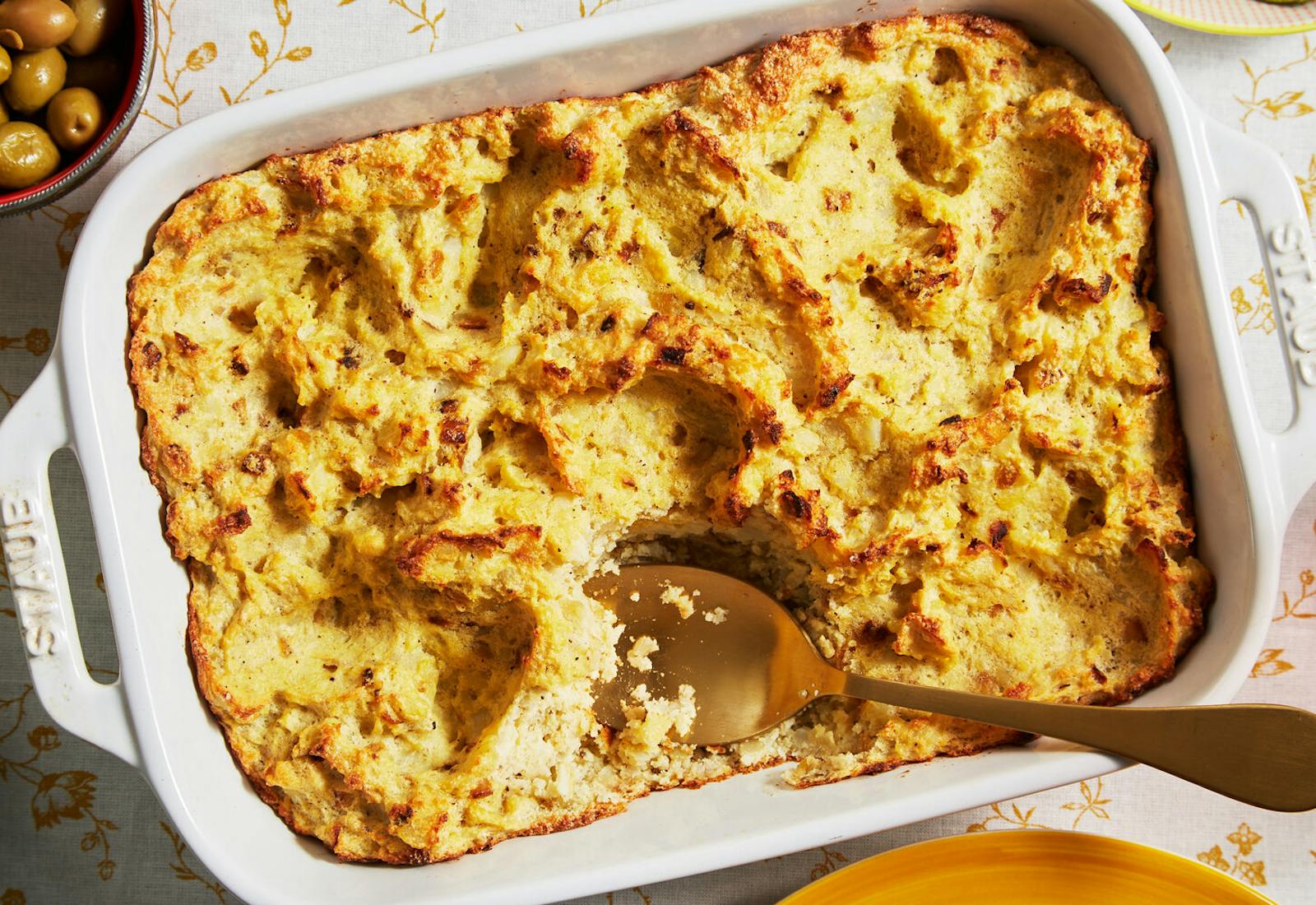
9. Cojada (Potato Casserole)
Yield: 4 to 6 servingsTime: 1 h 30 minThis recipe was shared by Esther Serruya Weyl. Read more about her family in " 130 Years in, a Brazilian Community’s Shabbat Recipes Live On" and try her recipes for roasted pepper salad, dafina, and almoronía.
Ingredients
- 3 large russet potatoes
- 7 tablespoons + 2 teaspoons olive oil, divided
- 1 large yellow onion, finely chopped
- 1 teaspoon sugar
- 3 eggs
- 1 tablespoon kosher salt
- ¼ teaspoon ground black pepper
- ¼ teaspoon cumin
- ¼ teaspoon nutmeg
Preparation
Step 1
Preheat oven to 420 degrees.
Step 2
Place the potatoes in a large pot, cover with cold water, add about 3 tablespoons of salt. Place over high heat, bring to a boil and reduce heat to medium low, cooking the potatoes at a gentle simmer. Cook until fork tender, about 30 to 40 minutes. Drain potatoes from the water and set aside to cool.
Step 3
Grease an 11 x 5 inch casserole dish with 1 teaspoon of olive oil. Set aside.
Step 4
Heat 4 tablespoons of olive oil in a saucepan over medium high heat. Once oil is hot, add the onions and sugar and saute until golden brown, about 15 minutes. Set aside.
Step 5
Separate the egg yolks and egg whites. Reserve egg yolks. Place the egg whites into a stand mixer with a whisk attachment and beat on low for about 2 to 3 minutes. Increase speed to medium and whip the eggs for another 3 to 5 minutes until stiff peaks have formed. Set aside.
Step 6
Peel the potatoes and discard the skins. Smash the potatoes with a fork until a puree like consistency is formed.
Step 7
Place the smashed potatoes into a large mixing bowl. Add the caramelized onions, salt, pepper, cumin, nutmeg and egg yolks. Mix all the components with a large fork until combined well. Pour the whipped egg whites into the potato mix and gently fold it in until combined. Gently transfer the mixture into the casserole dish. Smooth out the top layer with a spatula. Sprinkly 1 teaspoon of olive oil on top and transfer to the oven. Bake for about 40 minutes until the cojada is golden brown on all edges.
Step 8
Serve hot.
Shared by Esther Serruya Weyl
10. Almoronia (Baked Chicken and Eggplant)
Yield: 6 to 8 servingsTime: 1 h 30 minShared by Esther Serruya Weyl
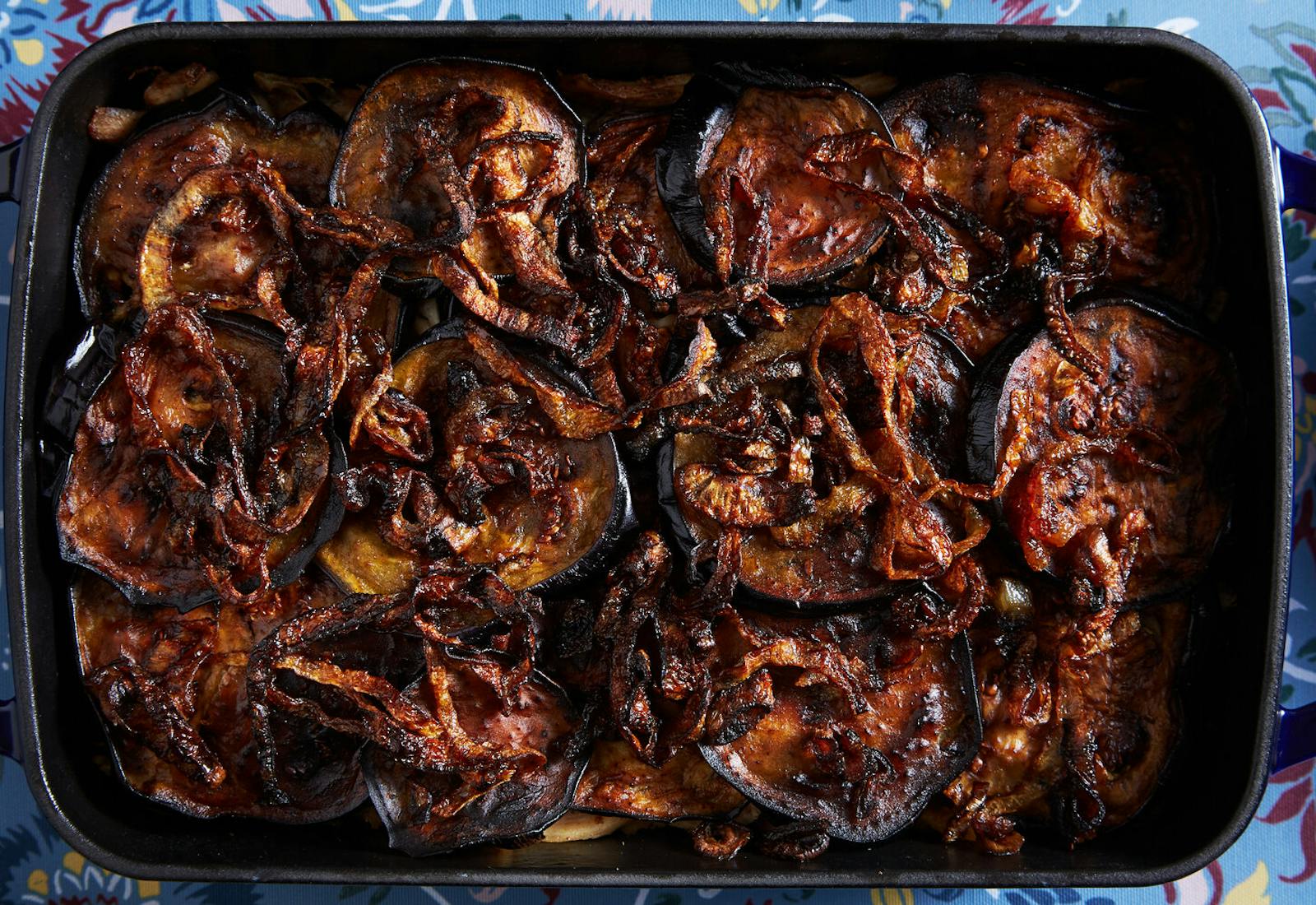
10. Almoronia (Baked Chicken and Eggplant)
Yield: 6 to 8 servingsTime: 1 h 30 minThis recipe is featured in our cookbook "The Jewish Holiday Table: A World of Recipes, Traditions & Stories to Celebrate All Year Long." For more holiday recipes from around the world, get your copy!
This recipe was shared by Esther Serruya Weyl. Read more about her family in " 130 Years in, a Brazilian Community’s Shabbat Recipes Live On" and try her recipes for roasted pepper salad, dafina, and cojada.
Ingredients
- 2 pounds bone-in, skin-on chicken thighs
- Kosher salt and freshly ground pepper
- 2 large eggplants (about 2 pounds), not peeled, cut into ¼-inch rounds
- Extra-virgin olive oil
- 4 medium yellow onions (about 1¼ pounds), thinly sliced
- 2 tablespoons honey
- ½ teaspoon ground cumin
- ½ teaspoon ground nutmeg
- ½ teaspoon ground cinnamon
Preparation
Step 1
Preheat the oven to 425°F.
Step 2
Season each chicken thigh with about 1 teaspoon salt (make sure to sprinkle the salt on all sides of the chicken) and a pinch of pepper. Arrange the chicken on a baking sheet, skin side up, and roast until the chicken is golden brown and very tender when pierced with a knife (the internal temperature should be about 175°F), 45 to 60 minutes, depending on the size of the pieces. Remove the chicken from the oven and set aside to cool for about 25 minutes.
Step 3
Reduce the oven temperature to 400°F.
Step 4
While the chicken is cooking, fry the eggplant: Place the eggplant slices on a wire rack and sprinkle them on both sides with salt, about 2 tablespoons total. Set the eggplant aside for about 30 minutes to draw out the juices.
Step 5
Pat the eggplant slices dry with a paper towel. Line a baking sheet with paper towels.
Step 6
Heat ⅓ cup olive oil in a large skillet over medium-high heat. Once the oil is hot, carefully add 4 eggplant slices, or as many as will fit comfortably without crowding, to the pan. Fry, turning once, until deep golden brown on both sides, 5 to 8 minutes per side. Transfer the fried eggplant to the paper towel-lined baking sheet. Continue frying the rest of the eggplant in batches, adding more oil to the pan and adjusting the heat as needed. If the fried eggplant slices look oily, blot the top surface with paper towels. Set the eggplant aside.
Step 7
Heat 2 tablespoons olive oil in a large skillet over medium-high heat. Add the onions and cook, stirring occasionally, until soft and golden brown, 20 to 25 minutes. Add 1 1/2 teaspoons salt and the honey to the onions and stir to combine. Remove from the heat and set aside.
Step 8
Once the chicken is cool enough to handle, pull the meat from the bones and shred it using two forks, aiming for bite-sized pieces. Cut or shred the skin as well (discard the bones). Put the shredded chicken and skin in a medium bowl. Add the cumin, nutmeg, and cinnamon and mix well to combine. Taste and add more salt and pepper as needed. Set aside.
Step 9
Assemble the almoronia: Arrange about half the eggplant in a 9-by-13-inch baking dish in an even layer, overlapping the slices as needed to fit. Spread half the shredded chicken over the eggplant in another even layer. Set aside about one-quarter of the caramelized onions and spread the rest over the chicken. Spread the remaining chicken into a layer on top of the onions, and top with the remaining eggplant pieces. Press gently to lightly compact the layers and make the almoronia easier to cut and serve, then distribute the reserved onions over the top.
Step 10
Bake the almoronia, uncovered, until all the ingredients are hot, about 30 minutes. Remove from the oven.
Step 11
To serve, scoop out portions, making sure to get a bit of each layer in each one, and arrange on plates.
Shared by Esther Serruya Weyl
11. Dafina (Overnight Shabbat Stew)
Yield: 6 to 8 servingsTime: 1 h active + 16 to 24 h inactiveShared by Esther Serruya Weyl
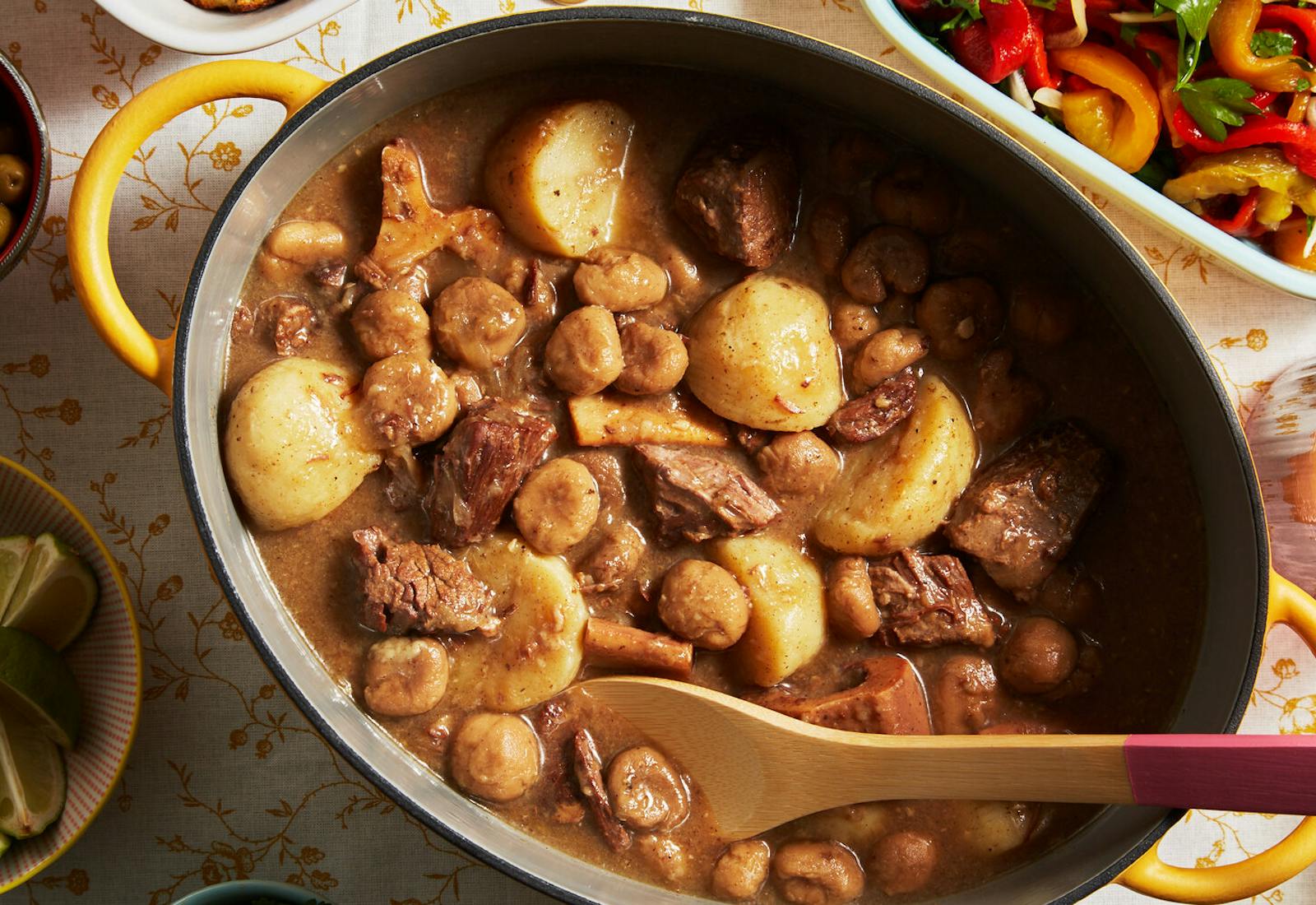
11. Dafina (Overnight Shabbat Stew)
Yield: 6 to 8 servingsTime: 1 h active + 16 to 24 h inactiveThis recipe is featured in our cookbook "The Jewish Holiday Table: A World of Recipes, Traditions & Stories to Celebrate All Year Long." For more holiday recipes from around the world, get your copy!
This recipe was shared by Esther Serruya Weyl. Read more about her family in " 130 Years in, a Brazilian Community’s Shabbat Recipes Live On" and try her recipes for roasted pepper salad, almoronía, and cojada.
Ingredients
For the beef bone and brisket marinade:
- 2 or 3 beef marrow bones, about 3 inches long
- 2 pounds brisket, chuck, or other beef stew meat, cut into 2-inch cubes
- 4 garlic cloves, finely chopped
- 2 tablespoons vegetable oil
- 1 tablespoon white vinegar
- 2 tablespoons kosher salt
For the dumplings:
- 1 ¾ cups all-purpose flour, plus more as needed
- 1 large egg
- ½ cup water
- ½ teaspoon kosher salt
For the dafina:
- 2 tablespoons vegetable oil
- 2 large yellow onions (about 1 pound), thinly sliced
- 6 garlic cloves, thinly sliced
- 2 teaspoons ground cinnamon
- 2 teaspoons ground cumin
- 1 teaspoon ground nutmeg
- ½ teaspoon sugar
- 1 tablespoon kosher salt
- ¼ teaspoon freshly ground black pepper
- 2 large russet potatoes, peeled and cut into quarters
- 4 to 6 large eggs
- About 5 cups water
Preparation
Step 1
Marinate the beef bones and brisket: Put the beef bones and cubed beef in a large bowl. Add the garlic, vegetable oil, vinegar and salt and mix and turn the ingredients until all the meat and bones are coated with the marinade. Cover the bowl with plastic wrap and refrigerate for at least 8 hours and up to 24 hours.
Step 2
Preheat the oven to 400°F. Line a baking sheet with parchment paper.
Step 3
Make the dumplings: In a large bowl, combine the flour, egg, water, and salt and stir until the ingredients come together into a dough.
Step 4
Turn the dough out onto the work surface and knead until smooth, about 5 minutes. Divide the dough into 4 pieces. Lightly flour your work surface and roll each piece into a rope about ½ inch thick.
Step 5
Cut one rope into ½-inch pieces. Roll each piece between your palms to form a spherical dumpling, and then poke a dimple into the center with your thumb. As you work, put the shaped dumplings on a plate or tray, keeping them separate so they don't stick together. Continue with the rest of the dough ropes until all the dumplings are formed. Sprinkle a generous few pinches of flour over the dumplings and toss until they're all lightly coated with flour, then spread the dumplings on the parchment-lined baking sheet.
Step 6
Bake the dumplings until they are golden brown and crisp, 20 to 30 minutes. Remove from the oven and set aside. Reduce the oven temperature to 220°F.
Step 7
Cook the dafina: Remove the beef bones and brisket from the marinade (discard the marinade) and pat dry with paper towels. Place a Dutch oven or other large-heavy-bottomed pot (large enough to hold all the ingredients) over medium-high heat and add 2 tablespoons oil. Once the oil is hot, add the bones and beef to the pot. Sear the meat and bones until nicely browned on all sides, about 15 minutes total, taking care that the pan juices don't get too dark and burn. Transfer the meat and bones to a bowl.
Step 8
Add about 2 tablespoons water to the pot, stirring and scraping the bottom of the pot to dissolve the pan juices, then simmer for a few seconds, until the liquid has evaporated. Add the onions and garlic and sauté until they are a deep golden brown, 15 to 20 minutes, adjusting the heat if the onions or garlic are getting too dark. Add the cinnamon, cumin, nutmeg, sugar, salt, and pepper and cook for another minute, stirring to distribute the spices.
Step 9
Put the seared meat and bones back into the pot and add the potatoes and eggs. Add enough water to just barely cover the ingredients; it's fine if the bones are a bit above the water level. Gently stir the mixture to distribute the ingredients and bring the liquid to a boil.
Step 10
Cover the pot with a lid and transfer to the oven. Cook the dafina for 1 hour.
Step 11
Take the pot out of the oven, add the baked dumplings, along with any flour on the baking sheet, and gently stir the mixture. Cover the pot again and return it to the oven. Cook the stew for at least 8 hours longer or overnight. Remove from the oven.
Step 12
Taste the cooking liquid and adjust the seasoning with more salt if needed. Remove the eggs, peel them, and return them to the dafina.
Step 13
To serve, put some beef, potatoes, and dumplings into each serving bowl and then ladle over the cooking liquid. Distribute the eggs and marrow bones to a few lucky diners.
Shared by Malena Svarch
12. Ropa Vieja (Beef Braised With Tomatoes and Spices)
Yield: 8 servingsTime: 3h or 1h 15min with pressure cookerShared by Malena Svarch
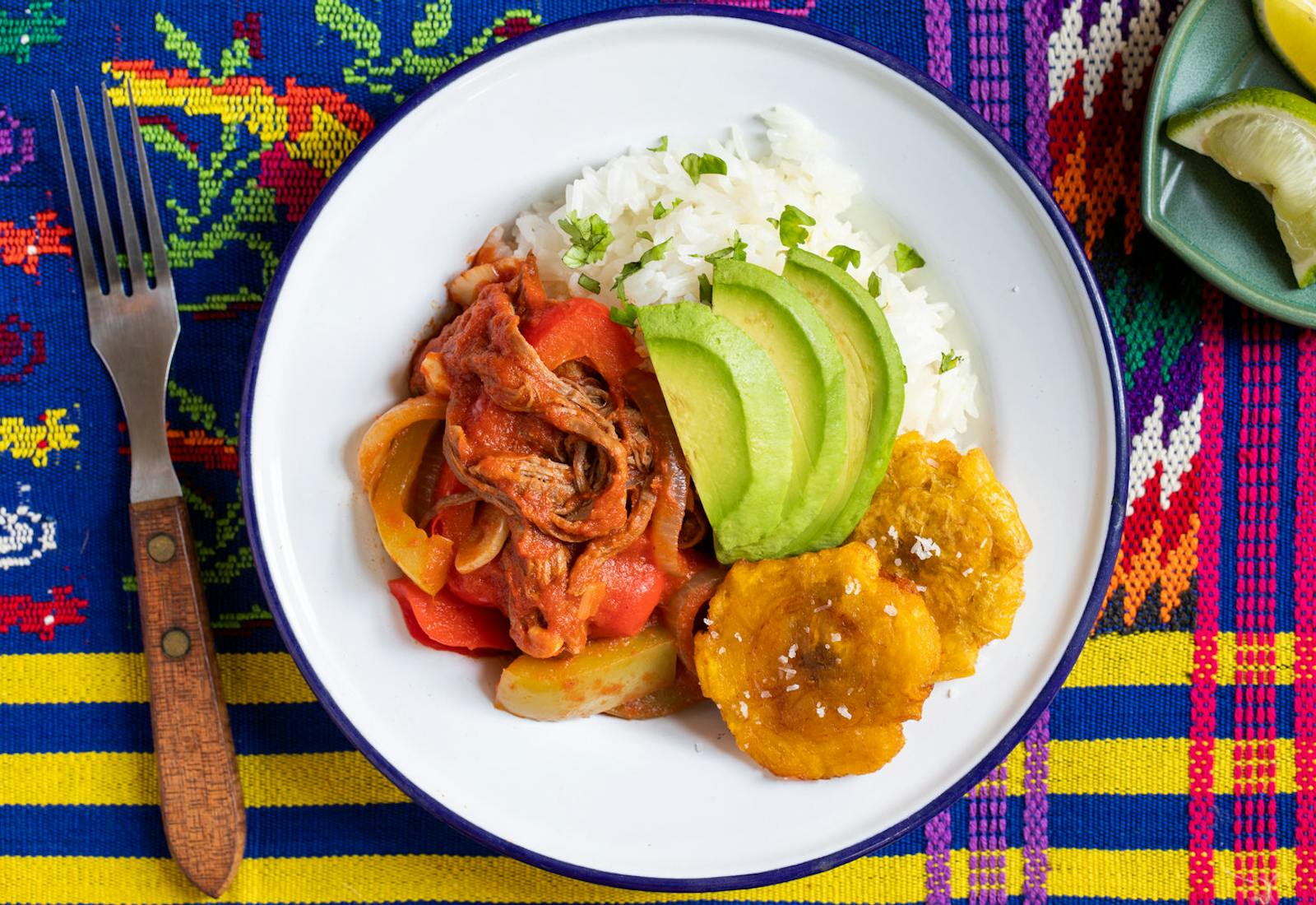
12. Ropa Vieja (Beef Braised With Tomatoes and Spices)
Yield: 8 servingsTime: 3h or 1h 15min with pressure cookerThis recipe was shared by Malena Svarch. Read more about her family in "Even 1,300 Miles from Home, A Young Cook Remembers Havana" and try her recipes for tostones and pastelitos (sweet hand pies filled with guava and cheese).
Ingredients
For the meat:
- 2 pounds flank steak
- 2 bay leaves
- ½ yellow onion, peeled and cut in half
- 4 cups chicken stock
For the sofrito:
- ¼ cup of olive oil
- 1 medium red bell pepper, cut into ¼ inch slices
- 1 medium green bell pepper, cut into ¼ inch slices
- 1 ½ yellow onions, sliced
- 3 garlic cloves, sliced
- 28 oz. can of tomato puree
- 1 ½ cups white wine
- 1 teaspoon of cumin
- ½ teaspoon of smoked paprika
- 1 teaspoon kosher salt
- ⅛ teaspoon freshly ground black pepper
- 1 bay leaf
For the rice:
- 1 tablespoon olive oil
- 2 cups of jasmine rice
- 1 garlic clove, peeled and crushed but left whole
Preparation
Step 1
Place the meat, bay leaves, garlic, onion and chicken stock in a pressure cooker set over high heat. Cook until the meat is tender and easily shreddable, about 35-40 minutes. If you do not have a pressure cooker, place ingredients in an oven-safe pot with a lid and braise at 325°, until meat is tender and shreddable, 2-2 ½ hours. Once meat is braised, shred with a fork.
Step 2
Heat the olive oil in a medium pot over high heat. Add the red and green bell pepper and sauté for 5 minutes to soften. Add the onion and garlic and sauté for 3-5 more minutes. Add the tomato puree, wine, cumin, smoked paprika, salt and pepper. Cover and cook over medium heat for 15 minutes until the sauce thickens.
Step 3
Add the meat and stir to combine with the sauce. Add the bay leaf. Cover and cook for 5 minutes. Taste and adjust for seasoning.
Step 4
Serve immediately with rice (see below), freshly sliced avocado, and tostones.
Step 5
Heat the oil and crushed garlic clove over medium heat in a medium saucepan. Add rice and mix to coat with oil. Add 4 cups of water and ½ teaspoon of salt. Cover and simmer over medium heat for 15 minutes. Turn off heat and let sit for 5 more minutes. Fluff and serve.
Shared by Vivian Wecselman-Fishman
13. Pastel de Choclo (South American Corn and Beef Casserole)
Yield: 6-8 servingsTime: 1 H + 2 H inactiveShared by Vivian Wecselman-Fishman
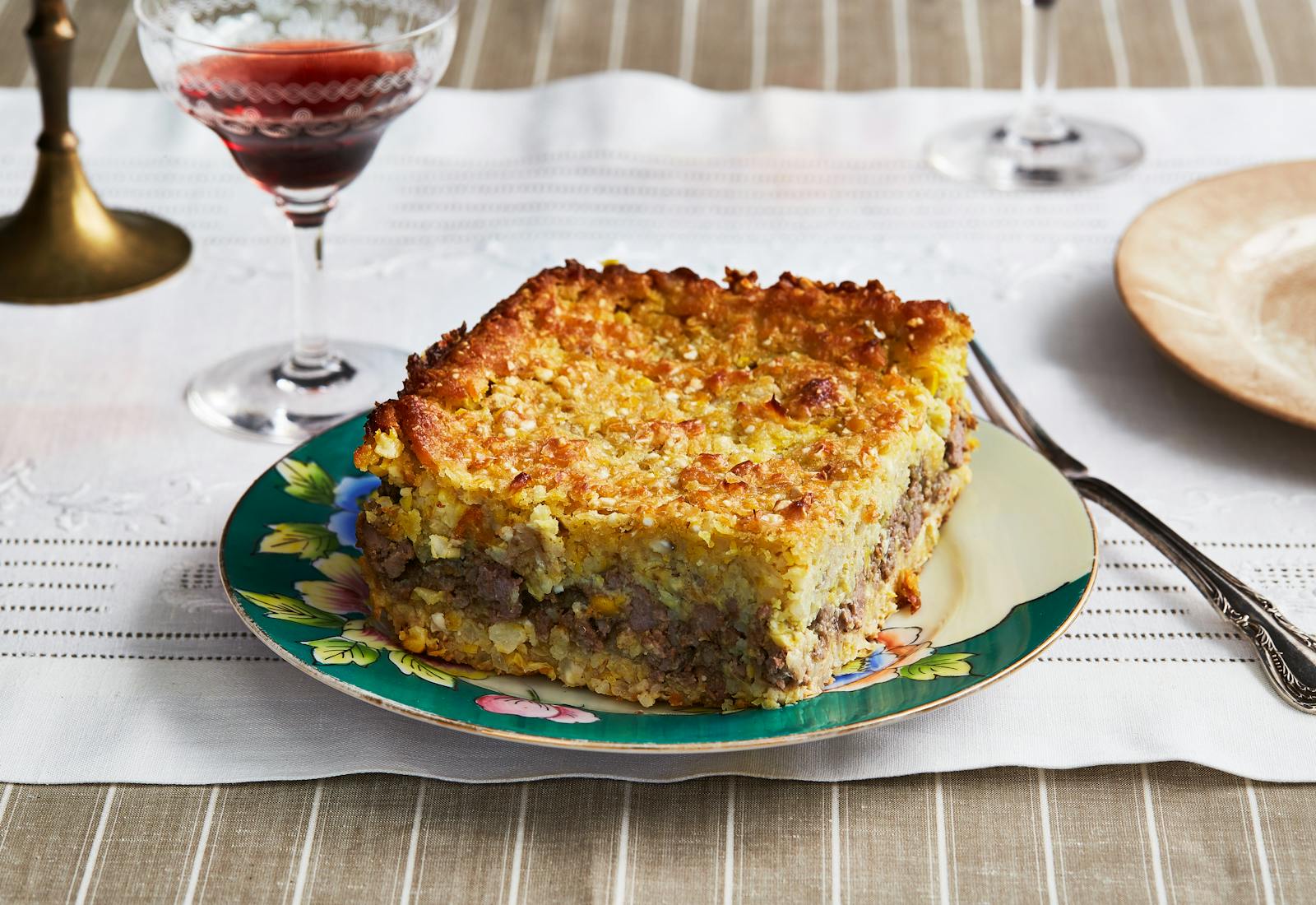
13. Pastel de Choclo (South American Corn and Beef Casserole)
Yield: 6-8 servingsTime: 1 H + 2 H inactiveVivian Wecselman-Fishman’s mother Etienne used to make this South American casserole of beef layered with spiced cornbread for Shabbat dinners when they lived in Lima.
Try Vivian’s recipes for tacu-tacu (Peruvian lima bean cakes) and ají de gallina (Peruvian chicken curry) and read more about her family in “Shabbat Dinner by Way of Romania and Peru.”
Ingredients
- 4 cups Peruvian choclo or 6 ears of yellow corn
- 3 tablespoons vegetable oil
- 2 garlic cloves, chopped and separated
- 1 red onion, diced
- 1/3 cup olive oil
- 1 lb ground beef
- 1 yellow onion, diced
- 1 ½ cup half-and-half milk, or ½ cup non-dairy creamer
- ½ cup unsalted butter or non-dairy butter, separated
- 3 tablespoons sugar (if one using yellow corn, you can skip the sugar)
- 2 teaspoons salt
- ⅛ teaspoon pepper
Preparation
Step 1
If you are using dried Peruvian choclo, place the kernels in a bowl with water and soak for at least 1 hour. Drain completely and pulse in a food processor into a grainy flour. If using American corn, simply remove the kernels from the cob and blend.
Step 2
Preheat the oven to 350 degrees.
Step 3
Prepare the beef filling: Pour 3 tablespoons vegetable oil into a large skillet and heat over medium heat. Add the red onion and saute until translucent, 5-7 minutes. Add one clove of chopped garlic and continue to cook over medium-low heat for 4 minutes. Add the beef, 1 teaspoon salt, and ⅛ teaspoon pepper to the skillet. Add ¼ teaspoon of aji, if using. Continue cooking, stirring often, for another 5 minutes until the beef is cooked through. Set aside to cool.
Step 4
Prepare the corn mixture: Add the butter or non-dairy butter (reserving 1 ½ tablespoons) into a deep skillet. Heat over medium and add in the yellow onion. Saute the onion and add 1 teaspoon of salt and 1 teaspoon aji, if using. Pour the blended corn into the skillet and add the half-and-half or non-dairy creamer. (If using American corn, start by pouring in just ½ cup of liquid at a time, stopping when the mixture becomes creamy and thick.) Cook for 4 minutes on a low heat, then set aside.
Step 5
Assemble the casserole: Grease a 12x8 inch baking dish. Pour half of the corn mixture evenly into the dish. Spread the entirety of the beef filling atop the mixture, and then cover it with the rest of the corn mixture.
Step 6
Slice the remaining butter or non-dairy butter and scatter over the casserole. Bake for 1 hour-1 hour 30 minutes, until the top has become golden brown.
Step 7
Serve warm with a side of aji amarillo.
Shared by Vivian Wecselman-Fishman
14. Ají de Gallina (Peruvian Chicken Curry)
Yield: 4 servingsTime: 1 H 30 minShared by Vivian Wecselman-Fishman
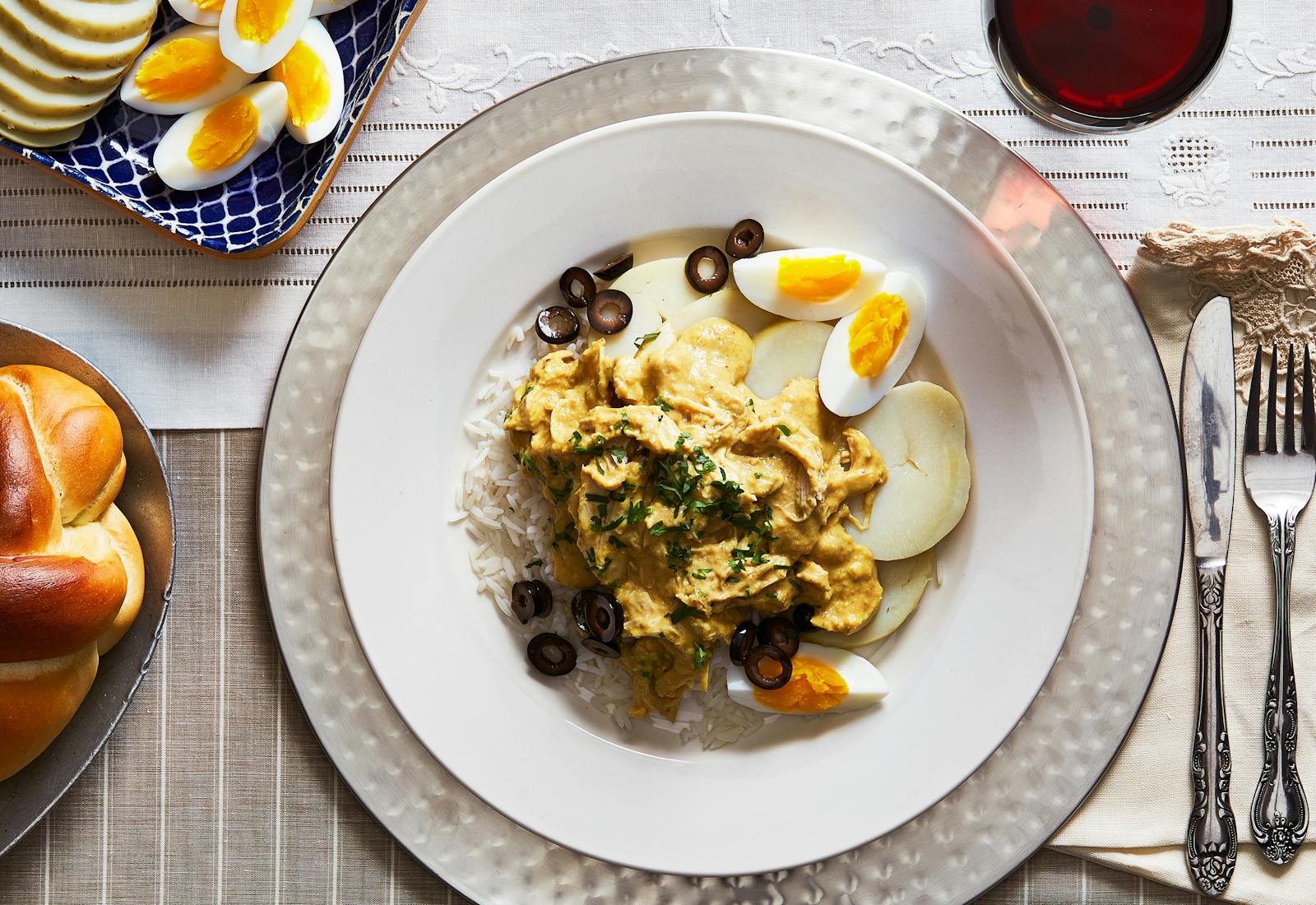
14. Ají de Gallina (Peruvian Chicken Curry)
Yield: 4 servingsTime: 1 H 30 minThe creamy sauce in this Peruvian classic has roots in Arab cooking that came with Spanish colonizers when they conquered the Inca Empire in the 16th century. In South America, cooks added aji amarillo, a local chile, to it, giving it its signature yellow hue and heat. When Vivian Wecselman-Fishman was growing up in Lima, the dish was served in her home for Shabbat.
Serve it with white rice to soak up the sauce, along with her tacu-tacu (Peruvian lima bean cake) and pastel de choclo (South American corn and beef casserole) and read more about her family in “Shabbat Dinner by Way of Romania and Peru.”
Ingredients
- 2 chicken breasts, skinless and boneless
- 2 ½ teaspoons salt, separated
- ⅛ teaspoon pepper
- 2 white potatoes
- 2 tablespoons vegetable oil
- 1 medium red onion, finely chopped
- 2 garlic cloves, finely chopped
- ¼ teaspoon turmeric powder
- 1 tablespoon ají amarillo
- 6 saltine crackers
- 8 whole pecans
- ½ cup coconut milk
- 2 eggs
- 8 pitted black olives
- Parsley for garnishing
Preparation
Step 1
In a large pot, cover the chicken breasts with 5 cups of water, 1 teaspoon salt and ¼ teaspoon pepper. Bring the water up to a boil and then immediately lower the heat to a simmer. Cover and cook for 10 minutes. Once the chicken breasts are cooked through, set them aside to cool. Shred the cooled chicken and set it aside. Strain the broth and set aside.
Step 2
Prepare the potatoes: Place the potatoes in a medium pot and cover water. Add ½ teaspoon salt and bring to a boil over high heat. Reduce the heat to medium and simmer for about 15 minutes or until fork tender. Remove the potatoes from the pot and set aside to cool. Once cooled, slice them into 3/4 inch thick coins.
Step 3
Prepare the eggs: Place the eggs in a small pot and cover them with 1 inch of water. Bring to a boil and then cook for 10-12 minutes depending on how soft you want the yolks. Immediately place them into an ice bath and set aside to cool. Once cooled, peel and quarter the eggs.
Step 4
Make the curry sauce: In a skillet, heat the vegetable oil over a medium flame. Place the onion and garlic into the skillet and saute until the onion has softened, about 5 minutes. Season with 1 teaspoon salt, ¼ teaspoon pepper, the turmeric and aji amarillo. Stir for a few minutes then set aside to cool for at least 10 minutes. Transfer the cooled onion mixture into a food processor with the crackers, pecans, and two cups of chicken broth. Blend until the mixture is smooth and thick.
Step 5
Assemble the curry: Return the curry sauce to the large skillet and add the shredded chicken and coconut milk. Simmer until the flavors meld and curry thickens. If the sauce becomes too thick, add more chicken broth until it is to your liking.
Step 6
Serve the chicken curry over white rice. Accompany with the boiled potatoes, pitted olives, and egg.
Step 7
Garnish with parsley.
Shared by Vivian Wecselman-Fishman
15. Tacu-Tacu (Peruvian Lima Bean Cakes)
Yield: 16 servingsTime: Overnight soaking, plus 2 H 30 minShared by Vivian Wecselman-Fishman
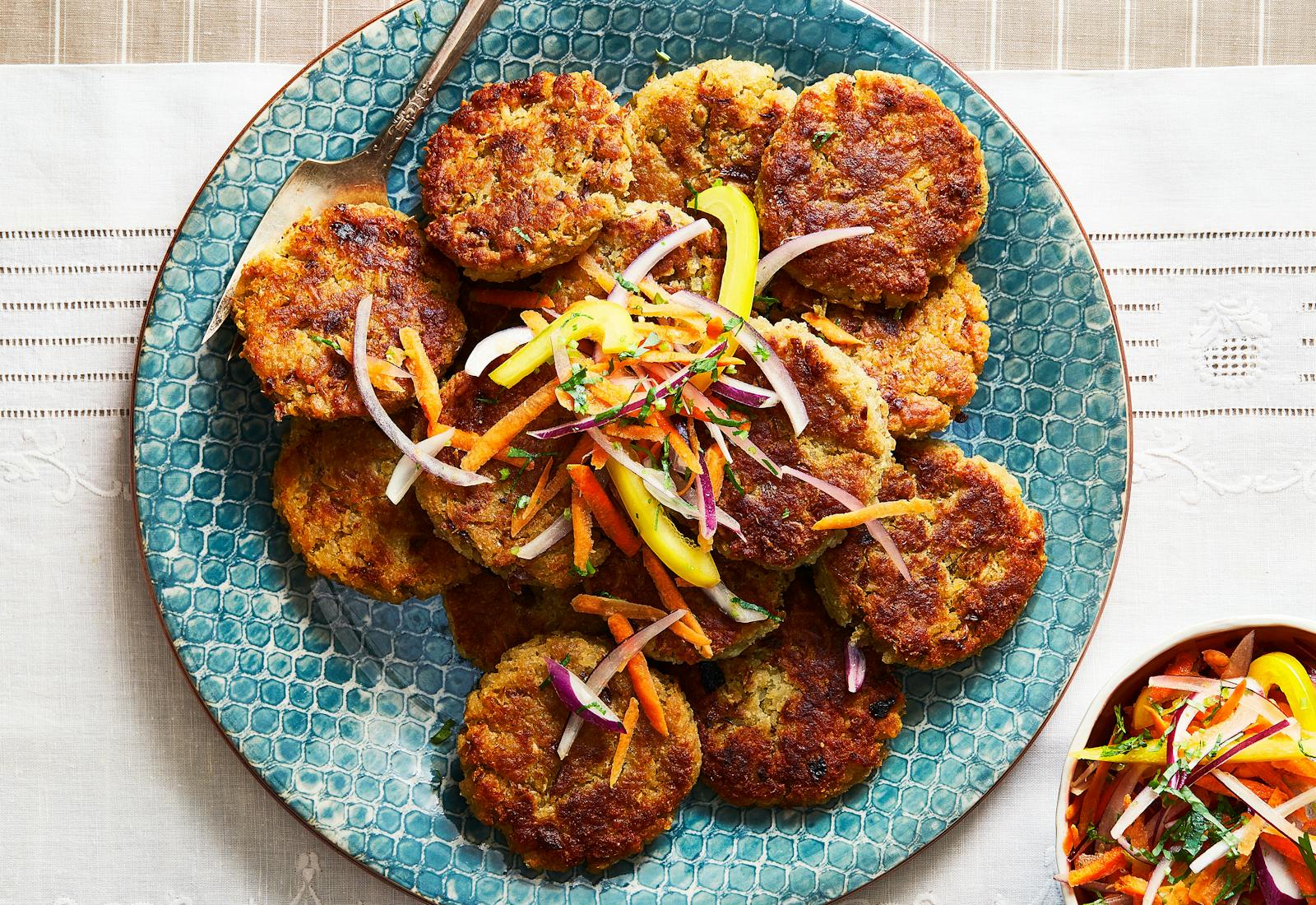
15. Tacu-Tacu (Peruvian Lima Bean Cakes)
Yield: 16 servingsTime: Overnight soaking, plus 2 H 30 minBeans and rice are formed into cakes or patties and fried for this Peruvian dish that Vivian Wecselman-Fishman’s mom used to make for Shabbat. The dish is one that came out of slavery, explains Peruvian chef Nico Vera. “In Peru, Afro-descended women fried leftover rice and canary beans with lard to make tacu tacu, a dish whose name comes from the Quechua word taku, which means ‘mixed.’ Today, tacu tacu is part of Peru’s Creole cuisine, and there are many popular variations.” In Vivian’s family, it’s made with lima or butter beans and served with the classic accompaniment salsa criolla.
Try Vivian’s recipes for pastel de choclo (South American corn and beef casserole) and ají de gallina (Peruvian chicken curry) and read more about her family in “Shabbat Dinner by Way of Romania and Peru.”
Ingredients
For the tacu-tacu
- 1 1/2 cups jasmine rice
- 2 cups lima or butter beans
- 1 red onion, medium chopped
- 2 tablespoons flour
- ½ teaspoon ají amarillo (optional)
- 2 teaspoons salt
- ⅛ teaspoon pepper
For the salsa criolla:
- 1 red onion
- 6 tablespoons vegetable oil, separated
- 3 teaspoons chopped cilantro
- 2 garlic cloves, grated
- 2 carrots, grated
- 2 tablespoons lime juice
- ⅛ cup yellow pepper, thinly sliced
Preparation
Step 1
Prepare the lima beans: The night before making this dish, soak two cups of dry lima beans in a large bowl of water. They will expand, so be sure to give them a lot of water and space. Rinse and strain the beans in the morning.
Step 2
Cook the rice: Wash the rice and let it sit on a strainer until it’s mostly drained. Heat 1 tablespoon of vegetable oil in a pan. Then add one teaspoon of fresh chopped garlic and 1 teaspoon salt. Stir well, preventing the garlic from burning. Add the raw rice to the garlic and mix it well while cooking it. Once the garlic has turned a golden color, pour 2 cups of water and stir a few times, making sure there isn’t anything stuck to the bottom of the pot. Cover the pot and leave the rice cooking on medium high heat until the water starts boiling. Right when it starts boiling, bring the heat to low and cook for approximately another 8 minutes. Turn off the heat and fluff with a fork. Set aside to cool.
Step 3
Cook the lima beans: In a skillet, heat 1 tablespoon vegetable oil and saute the onion, garlic and ½ teaspoon salt over medium heat for 5-7 minutes. Add in the lima beans and cook for another 4 minutes. Pour in 4 cups of water or enough to cover the mixture by two inches. Simmer for 1 hour or until the water has reduced and the beans have fallen apart. Remove the pot from the stove, strain and then mash the lima beans. Allow to cool to room temperature.
Step 4
In a large bowl, combine the cooked rice, lima beans, flour, 1 teaspoon of salt and aji (if using). The mixture should be thick and hold its shape when formed.
Step 5
In a skillet, heat 4 tablespoons of vegetable oil and heat over medium. Scoop about ¼ cup of the mixture into your hand and shape it into a round, flat cake with a 3 inch diameter. Fry each cake for about 3 minutes per side, making sure that they become golden brown and crispy.
Step 6
Make the salsa criolla: Slice the onion in half and then thinly slice crosswise. Soak it in a bowl of water with ½ teaspoon of salt for 10 minutes. Strain and pat dry. Mix in the chopped cilantro, lime juice, sliced peppers and 1 teaspoon salt and ⅛ teaspoon pepper. (Optional) Mix in ¼ teaspoon aji.
Step 7
Serve hot with fresh salsa criolla.
Shared by Esther Serruya Weyl
16. Meringue With Orange Marmalade
Yield: 6 to 8 servingsTime: 15 to 20 minShared by Esther Serruya Weyl
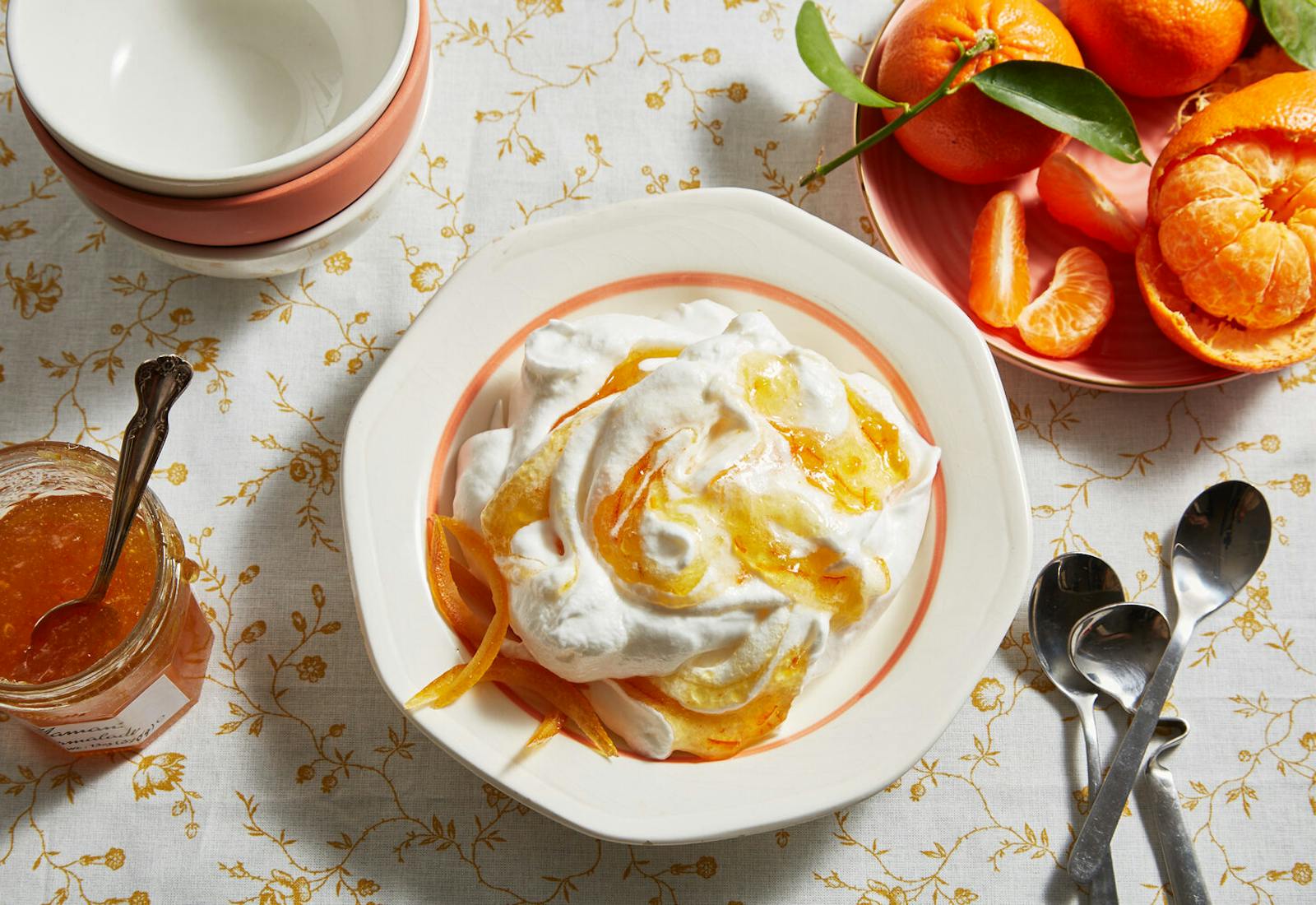
16. Meringue With Orange Marmalade
Yield: 6 to 8 servingsTime: 15 to 20 minIn Brazil, Esther prepares this meringue with the amazonian fruit cupuaçu, which is only available locally. In its place, Esther suggests using orange marmalade.
This recipe is featured in our cookbook "The Jewish Holiday Table: A World of Recipes, Traditions & Stories to Celebrate All Year Long." For more holiday recipes from around the world, get your copy!
This recipe was shared by Esther Serruya Weyl. Read more about her family in " The Recipes That Connect This Brazilian Community to Its Moroccan Roots" and try her recipes for escabeche de piexe and fish albondigas.
Ingredients
- 1½ cups sugar
- ¾ cup water
- 6 large egg whites
- 6 tablespoons orange marmalade
Special equipment:
- Candy thermometer
Preparation
Step 1
Put the sugar and water in a small saucepan and bring to a boil over medium-high heat, stirring just until the sugar is dissolved; don't stir after that, or the sugar might crystallize. Cook the sugar syrup until it reads 240°F on a candy thermometer (soft-ball stage); this will probably take 20 to 25 minutes.
Step 2
Meanwhile, as the sugar gets closer to the soft-ball stage, in the bowl of a stand mixer fitted with the whisk attachment, whip the egg whites until they form soft peaks.
Step 3
Remove the cooked sugar syrup from the heat and, with the mixer running on medium speed, very slowly drizzle the hot sugar mixture into the whipped egg whites. Continue mixing until the meringue forms stiff, glossy peaks.
Step 4
Transfer the meringue to a large bowl, add 3 tablespoons of the marmalade, and fold the marmalade into the meringue with just a few strokes, to create orange streaks. Transfer the meringue to a large serving bowl and top with the remaining marmalade, swirling it into the meringue to make a pretty design.
Step 5
Cover the meringue loosely with plastic wrap and refrigerate for 1 to 2 hours. Serve cold.
Shared by Monica Haim
17. Torta de Datiles (Date and Walnut Cake)
Yield: 16 squaresTime: 40 minShared by Monica Haim
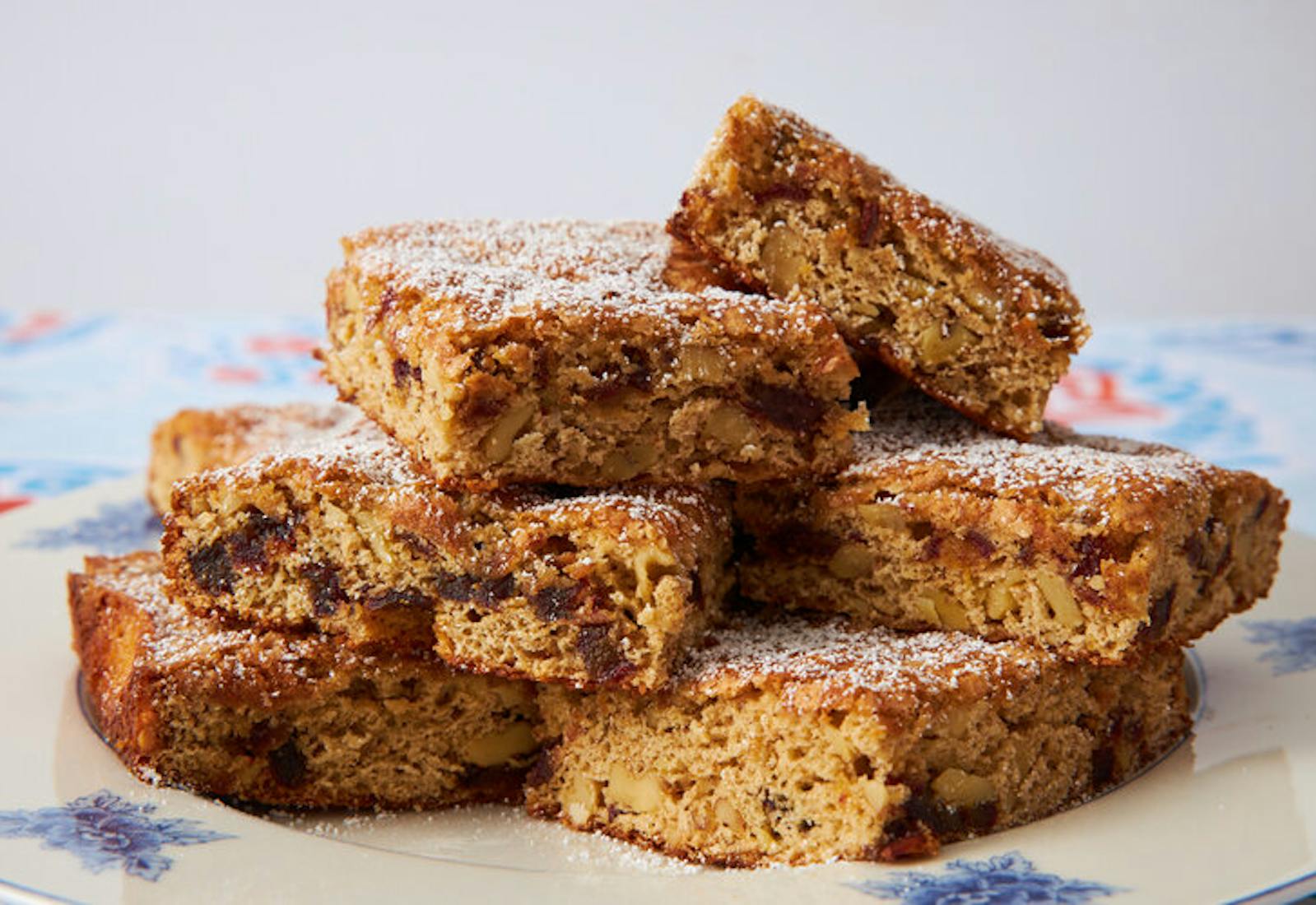
17. Torta de Datiles (Date and Walnut Cake)
Yield: 16 squaresTime: 40 minThis recipe was shared by Monica Haim. Read more about her family in "In Rural Alaska, Monica Haim Dreams of a Colombian-Miami Feast" and try her recipes for guava challah, arroz con fideos (rice with vermicelli noodles), and torta de espinaca (spinach and cheese pie).
Ingredients
- 1 tablespoon butter
- ¾ cup all-purpose flour, plus more for dusting the parchment
- 1 cup sugar
- 1 teaspoon baking powder
- 1 teaspoon cinnamon
- ¼ teaspoon kosher salt
- 1 cup dates, pitted and roughly chopped (about 8-10 dates)
- 1 cup walnuts, roughly chopped
- 2 eggs
- 1 teaspoon vanilla
Optional garnish
- 2 tablespoons confectioners’ sugar
Preparation
Step 1
Preheat the oven to 375 degrees. Line a 9-inch square baking dish with parchment paper. Grease the parchment with butter and sprinkle lightly with flour to coat. Tap the pan to discard the excess flour.
Step 2
In a mixing bowl, combine the flour, sugar, baking powder, cinnamon, and salt. Add the dates and nuts.
Step 3
In a small bowl, beat the eggs with 2 tablespoons of water and vanilla until combined well. Pour into the mixing bowl of dry ingredients and stir until smooth. The dough should be quite dry.
Step 4
Pour the batter into the baking dish and smooth it into an even layer with a spatula. Transfer to the oven, and bake for 20-25 minutes, or until a toothpick inserted into the middle comes out clean.
Step 5
Shared by Malena Svarch
18. Pastelitos (Sweet Hand Pies Filled With Guava and Cheese)
Yield: 18 pastelitosTime: 30min plus 25min baking timeShared by Malena Svarch
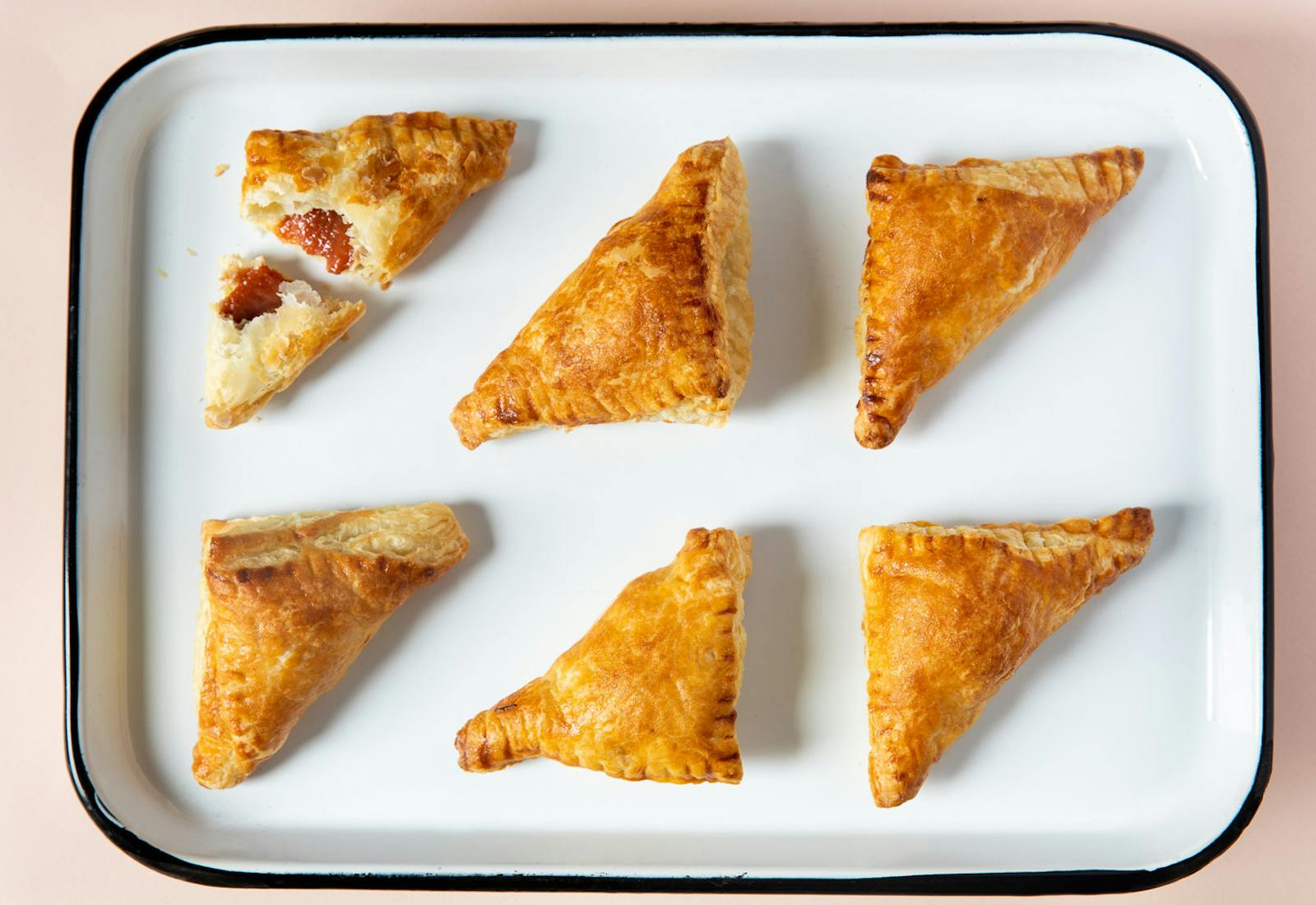
18. Pastelitos (Sweet Hand Pies Filled With Guava and Cheese)
Yield: 18 pastelitosTime: 30min plus 25min baking timeThis recipe was shared by Malena Svarch. Read more about her family in "Even 1,300 Miles from Home, A Young Cook Remembers Havana" and try her recipes for ropa vieja (beef braised with tomatoes and spices) and tostones.
Ingredients
- 2 sheets of puff pastry, cut into 9 squares (2x2 inches each)
- 1 16 oz. block of guava paste
- 1 8 oz. block of regular cream cheese, optional
- 1 large egg
- sugar for sprinkling
Preparation
Step 1
Preheat oven to 400° and line a baking sheet with parchment paper.
Step 2
Cut a ¼” rectangle of guava paste (about 2 teaspoons) and place in the center of one of the squares of puff pastry. Fold one corner of the square over the guava paste to meet the other corner, forming a triangle. Seal the edges by pressing along the entire edge of the triangle with a fork. For the cream cheese option, place ¼” rectangle of guava paste and a ¼” rectangle of cream cheese in the center of the puff pastry square and shape into a triangle, sealing the edges with the tines of your fork. Repeat with the remaining squares, choosing whatever filling you’d like until all the squares are full. Lay the pastries out on the prepared baking sheet.
Step 3
In a small bowl or jar, combine the egg and a teaspoon of water. Brush the pastelitos with the egg wash and sprinkle lightly with sugar.
Step 4
Bake for 20-25 minutes until golden brown and crispy.
Step 5
Let cool, and then serve immediately or reheat in the microwave and enjoy with morning with coffee!


